
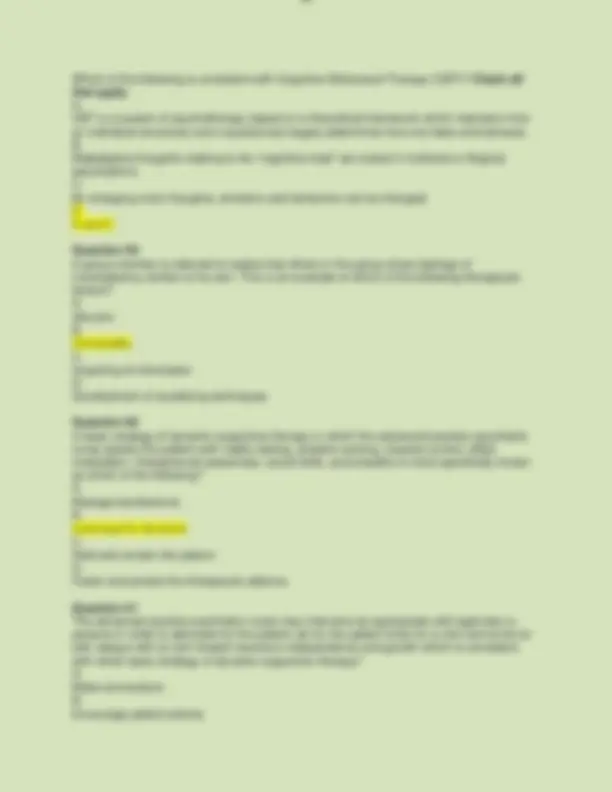
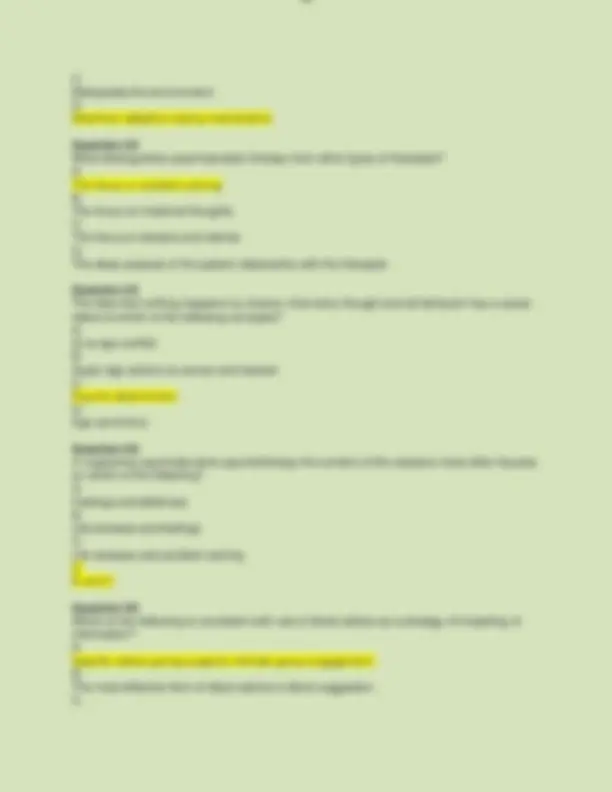
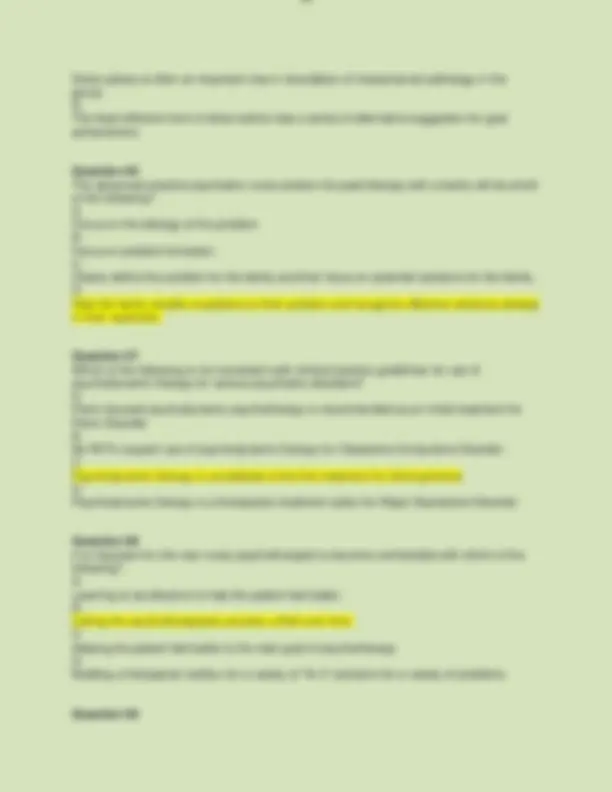
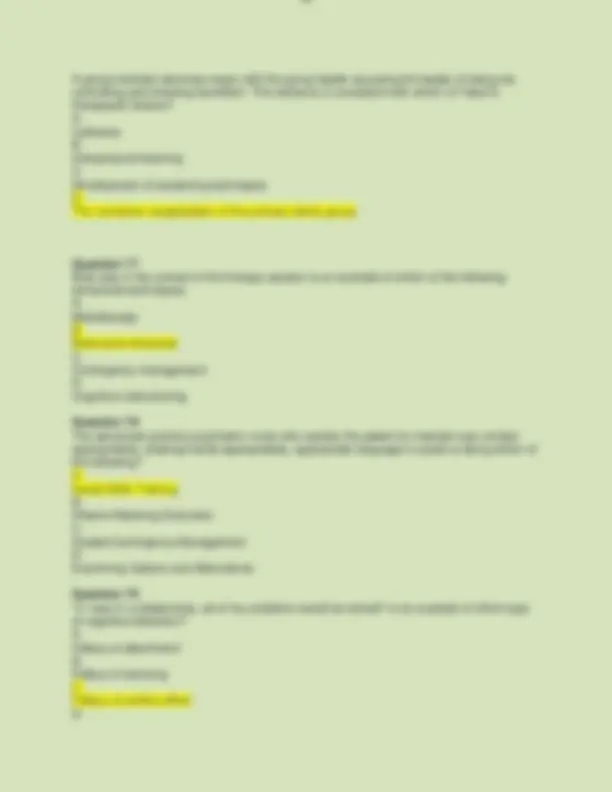
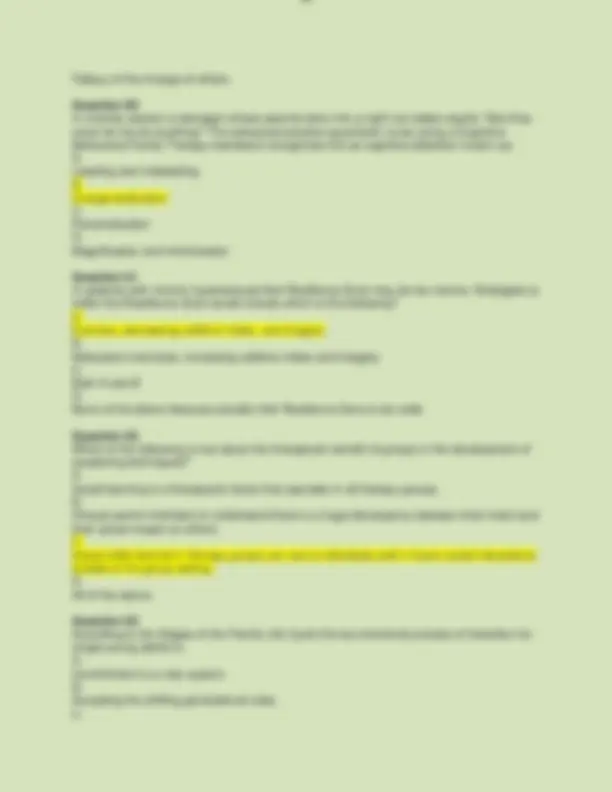
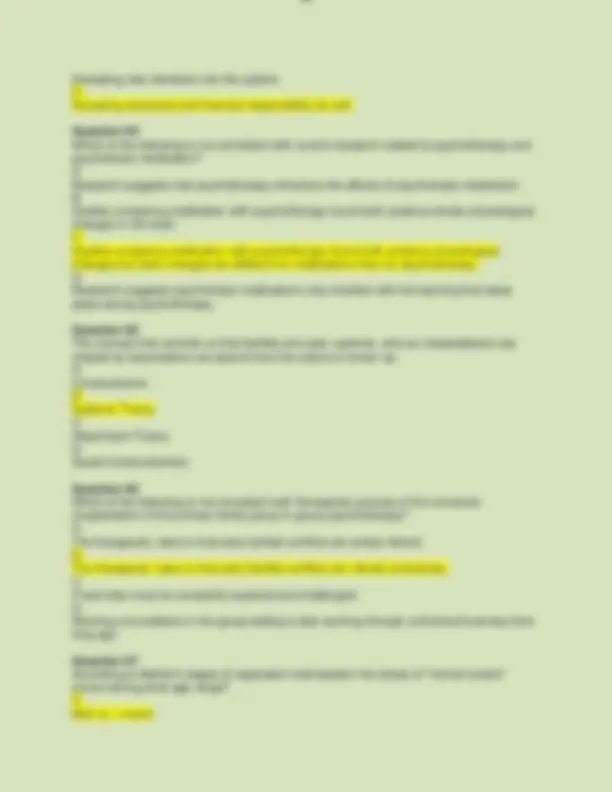
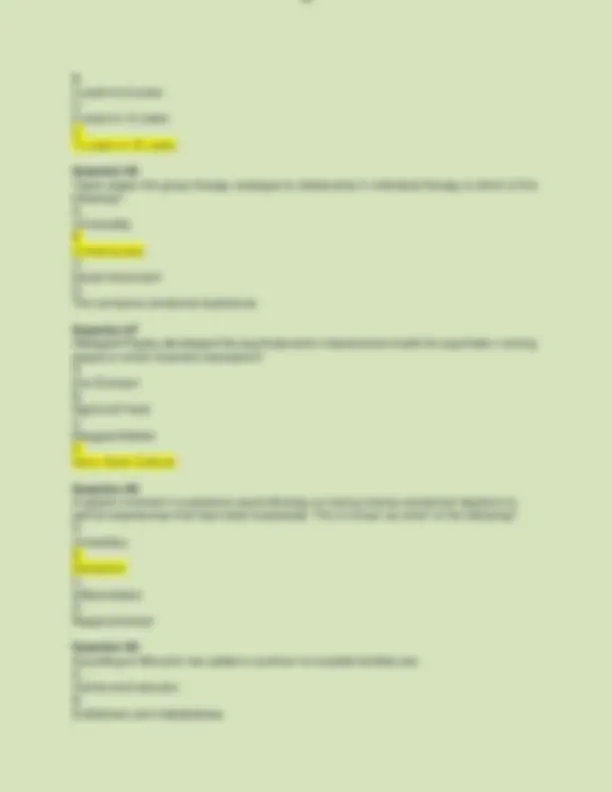
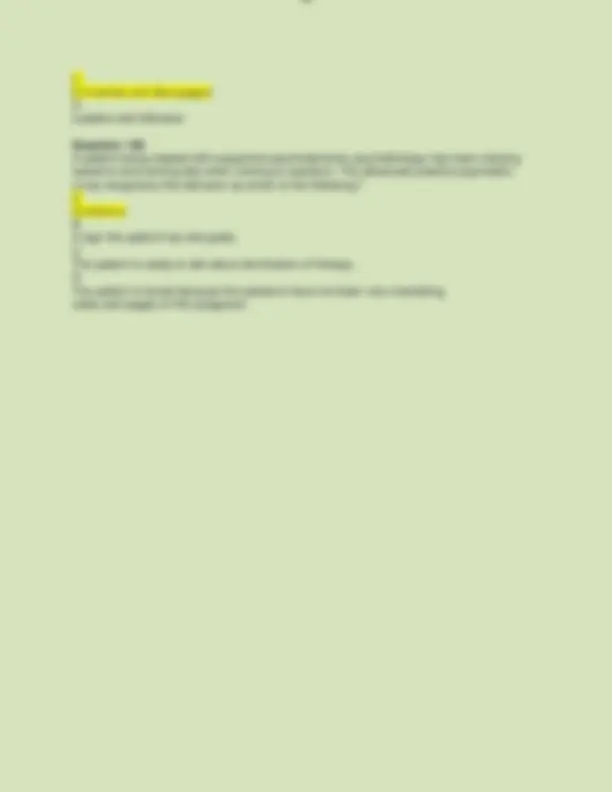
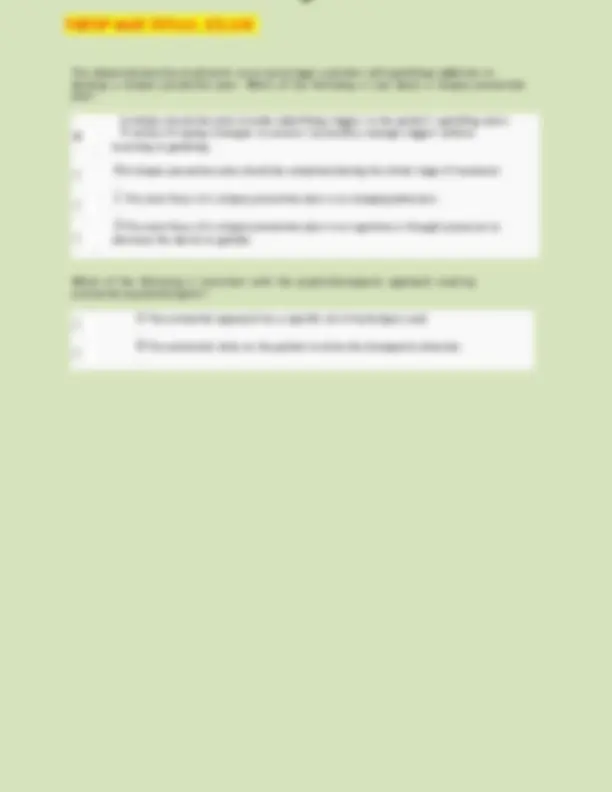
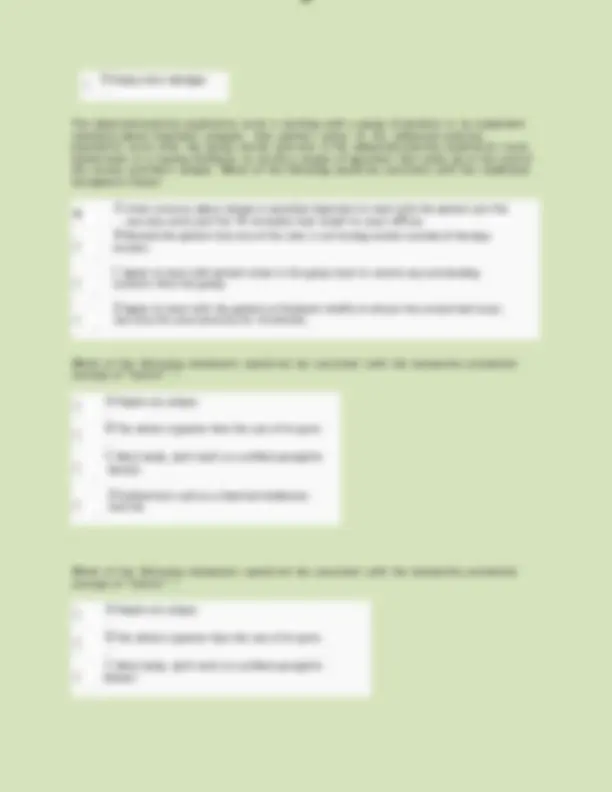
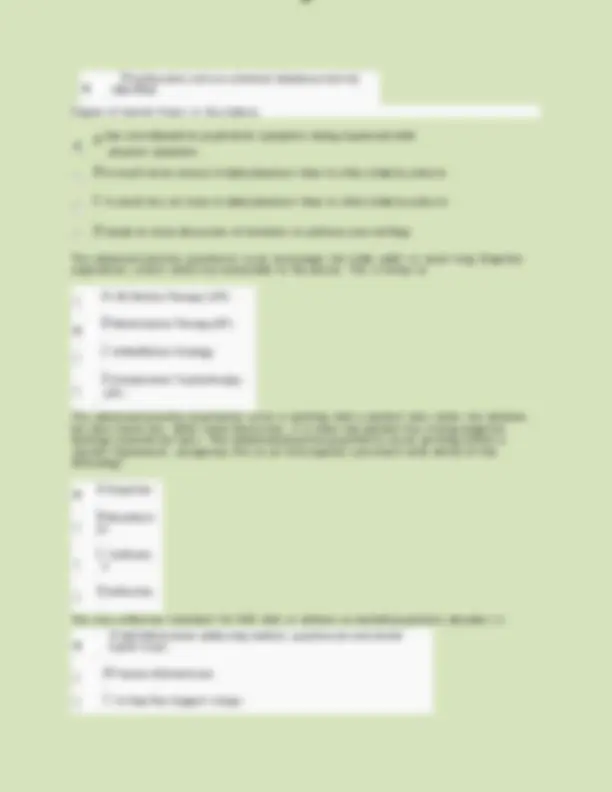
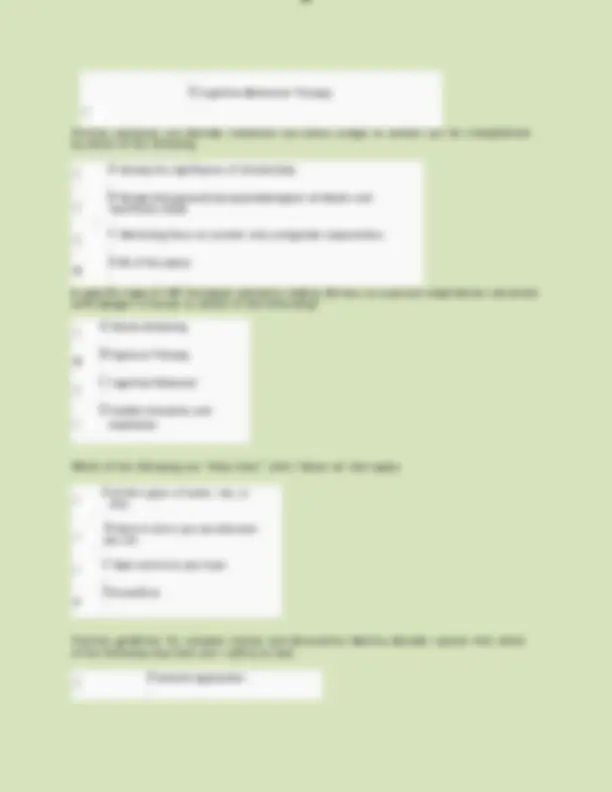
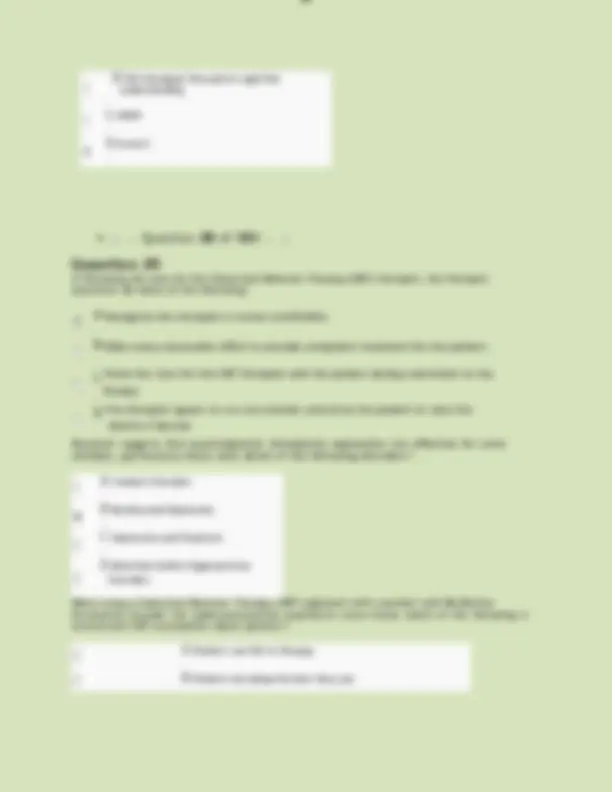
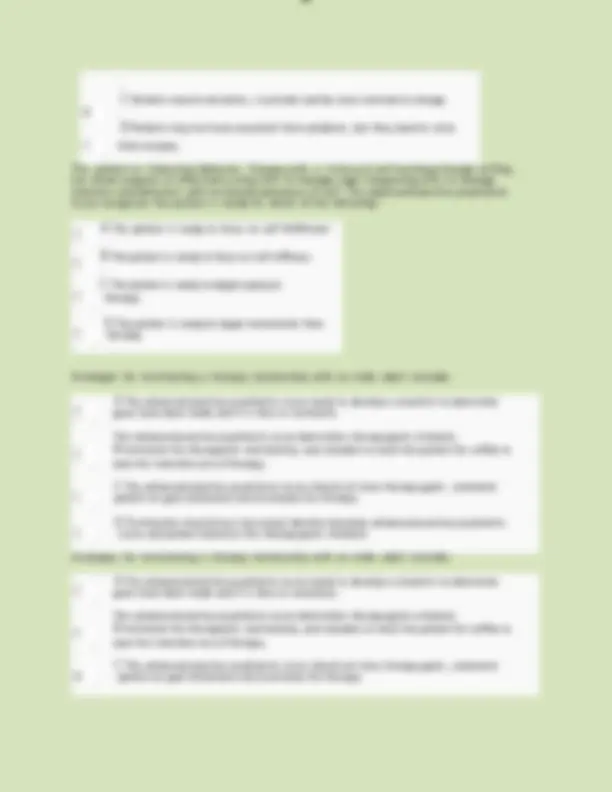
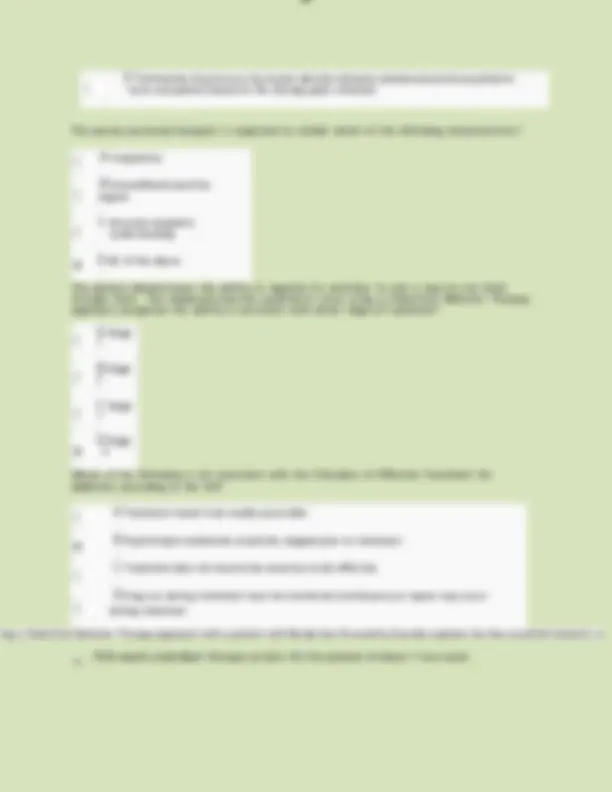
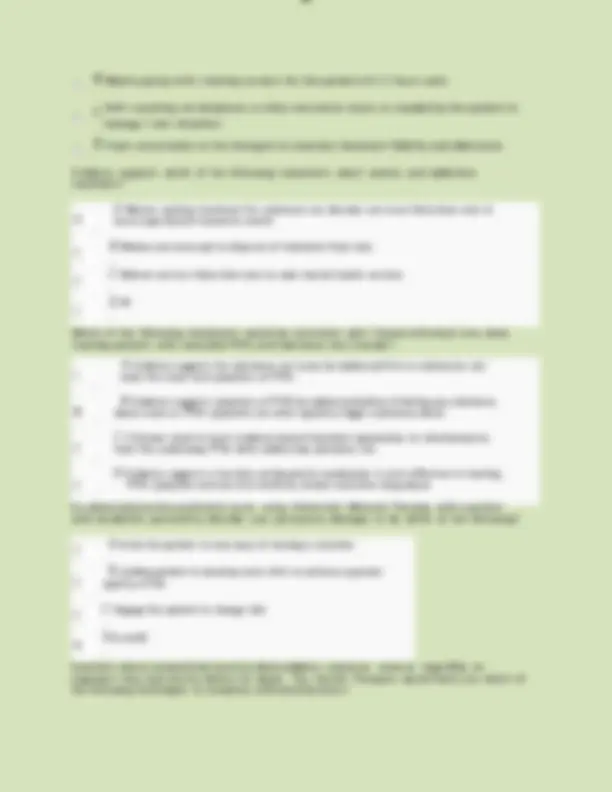
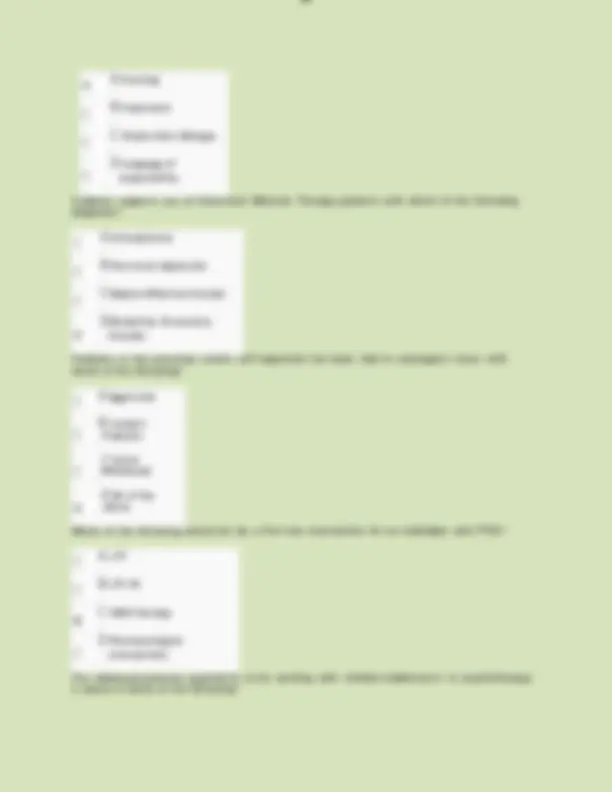
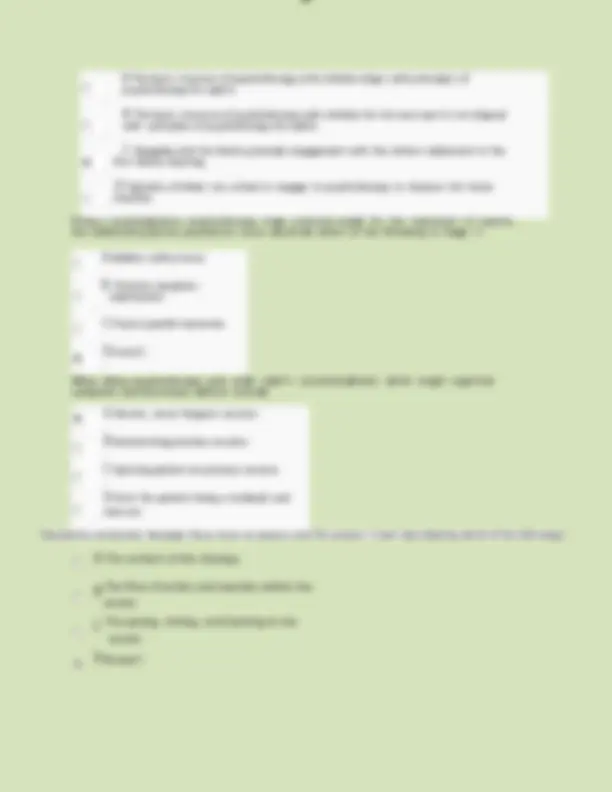
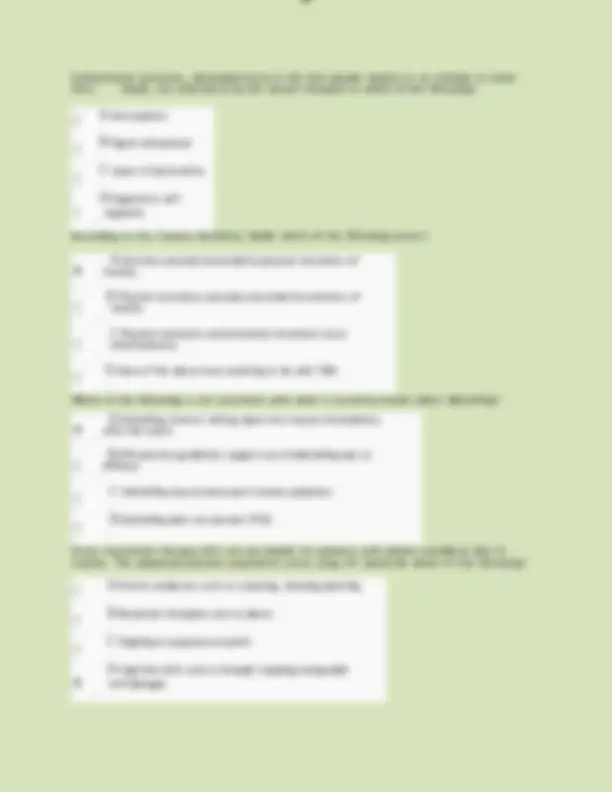
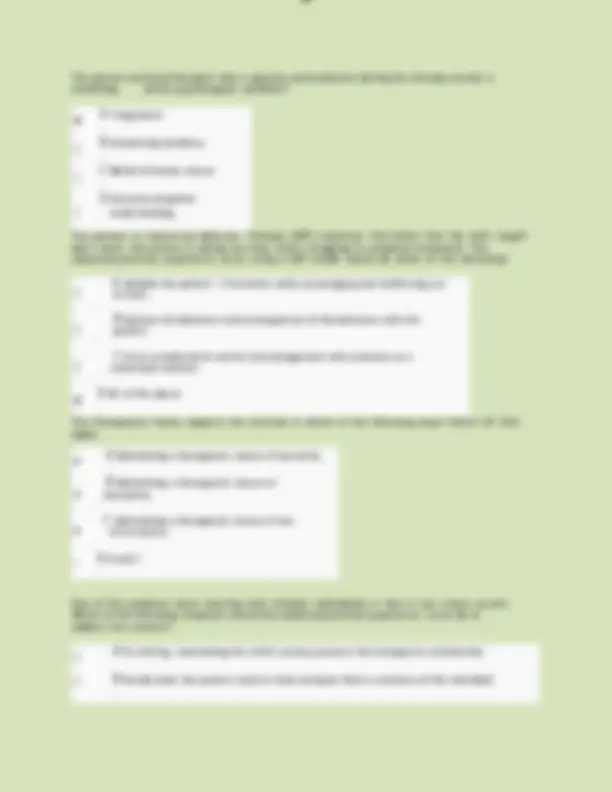
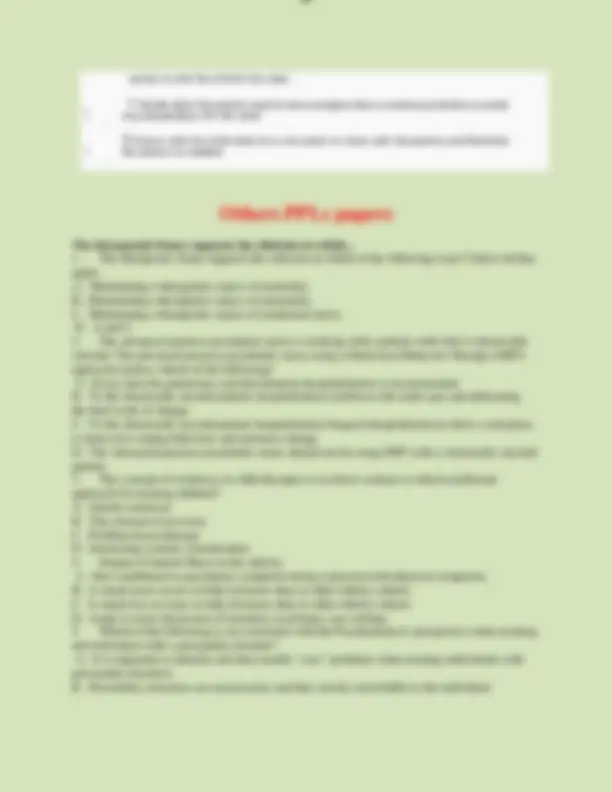
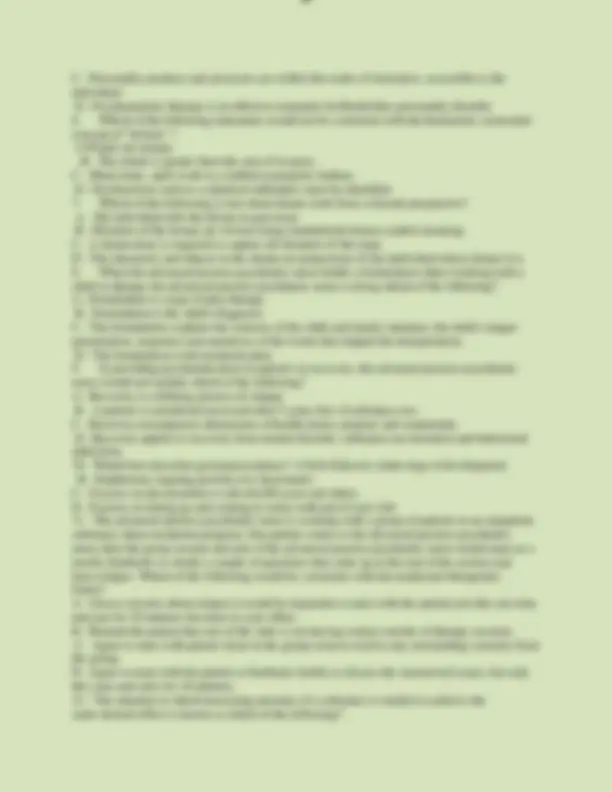
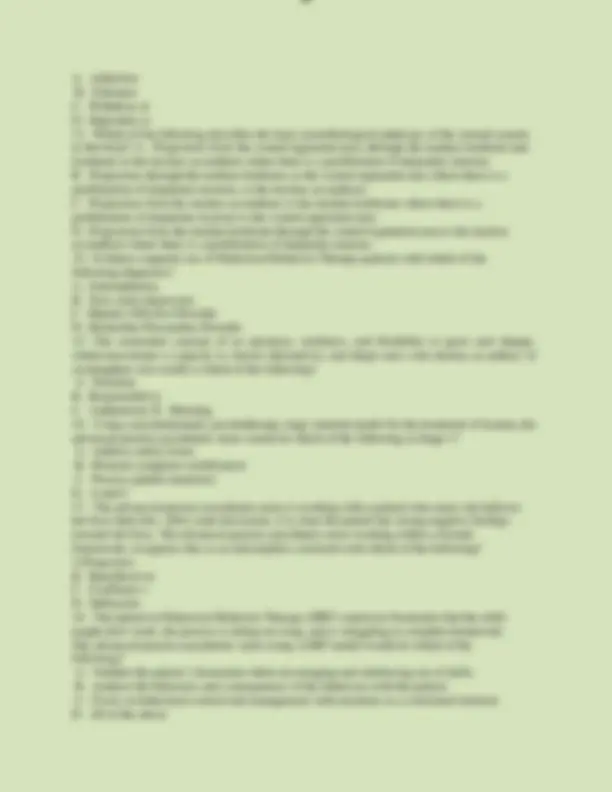
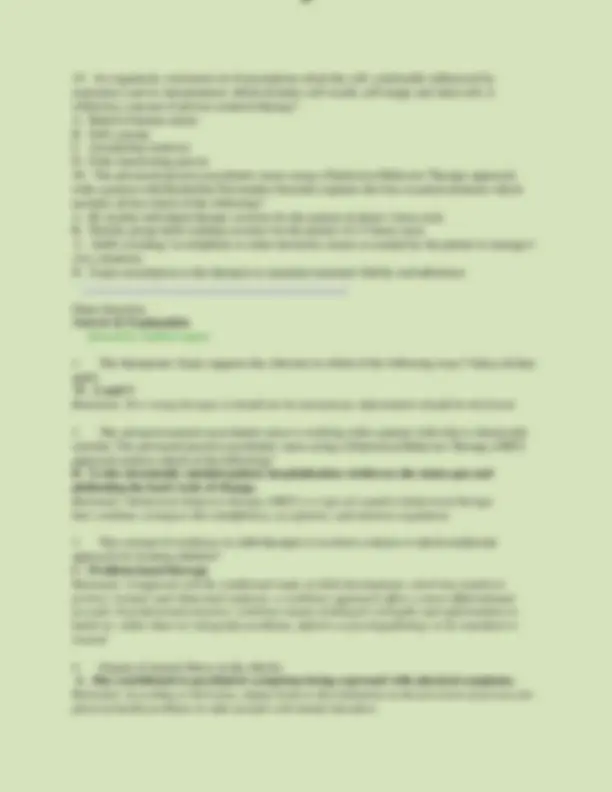
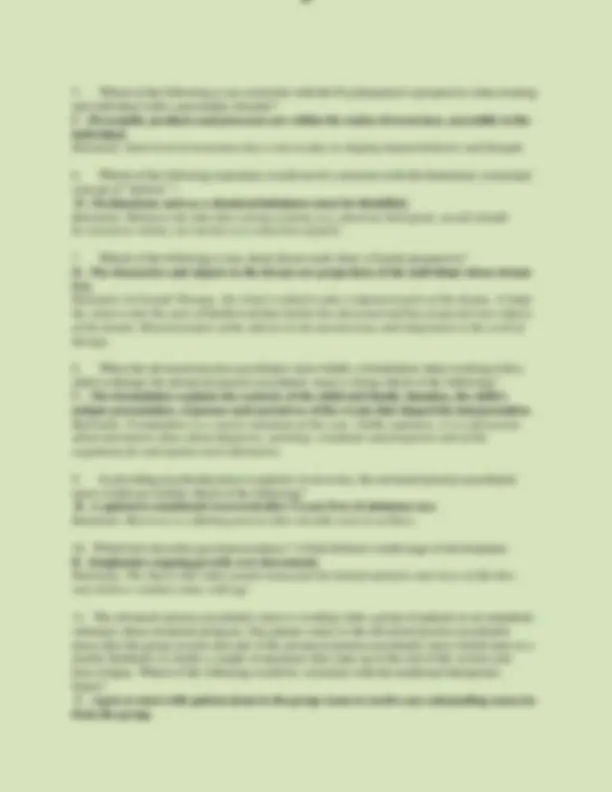
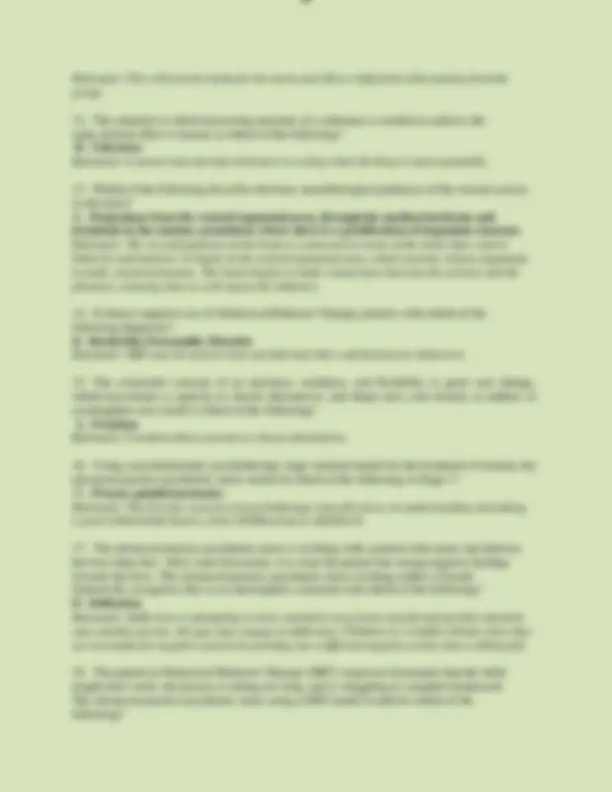
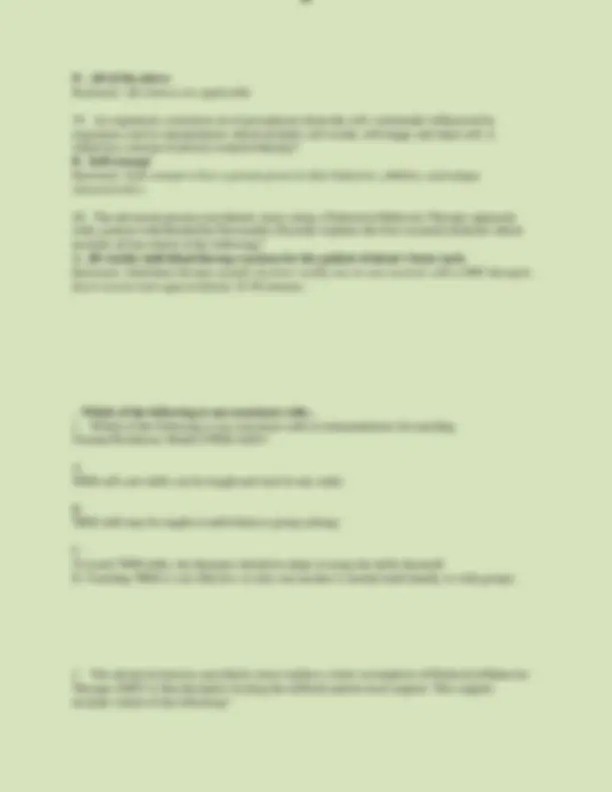
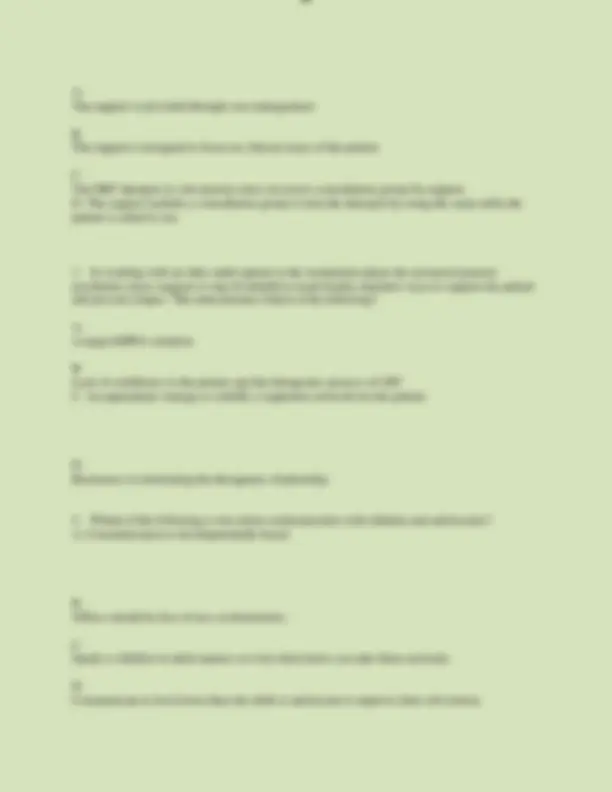
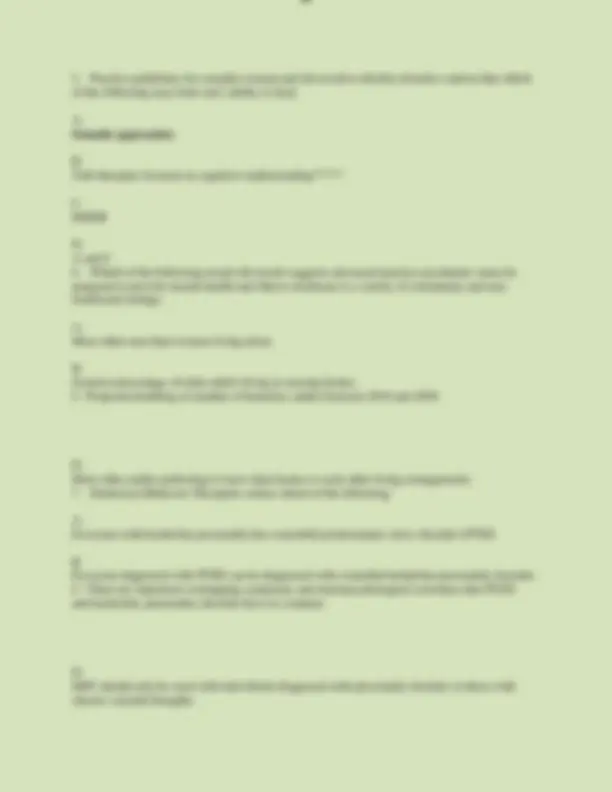
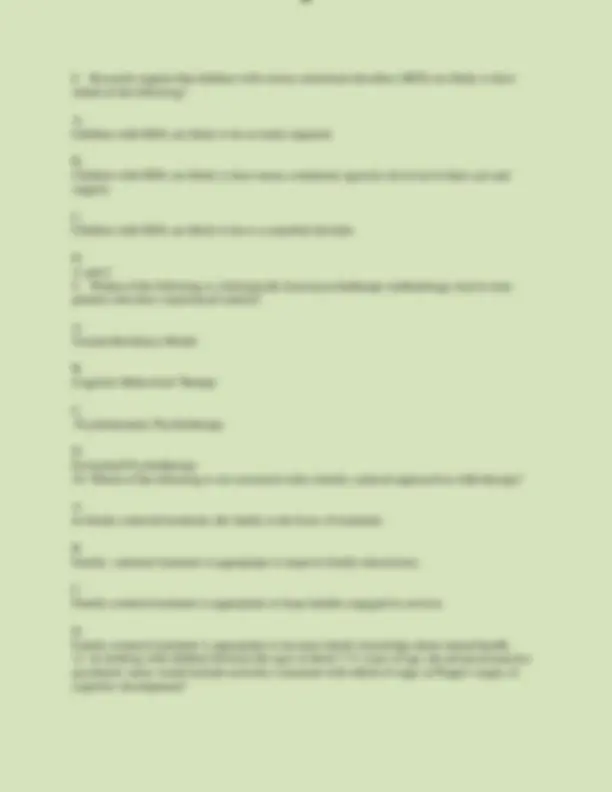
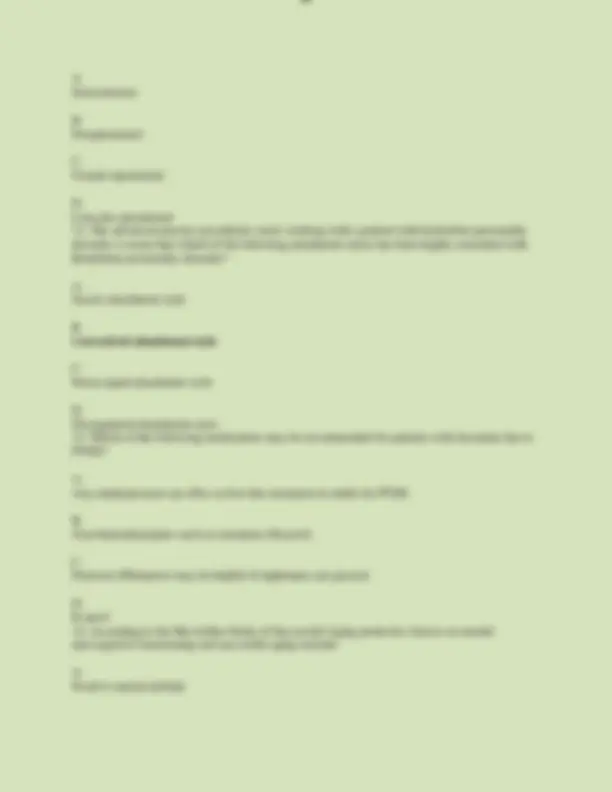
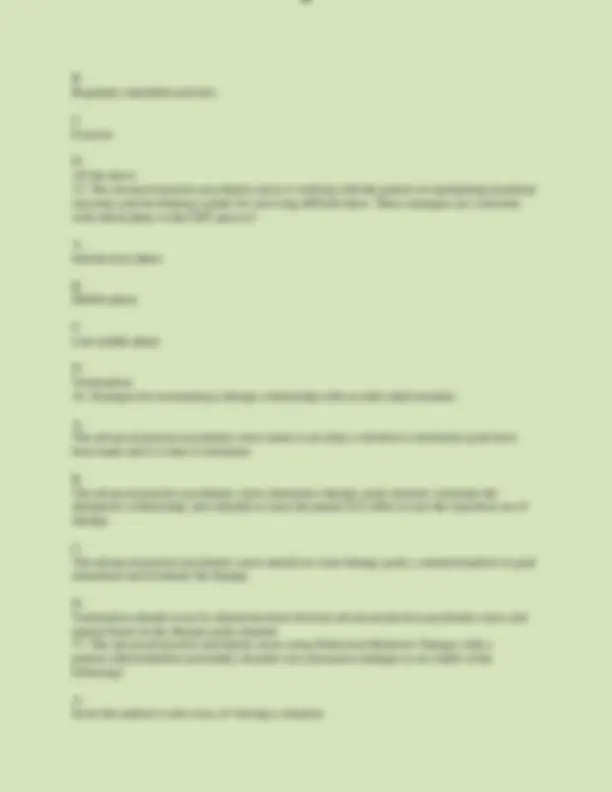
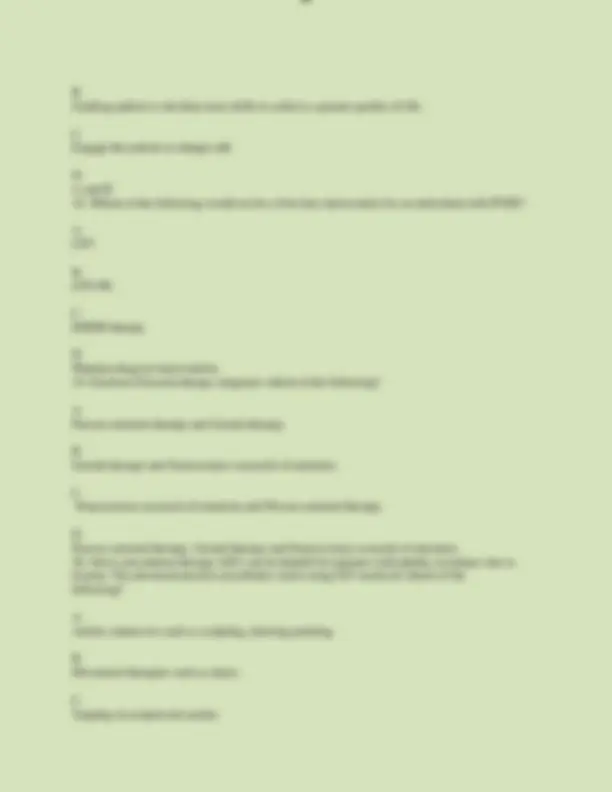
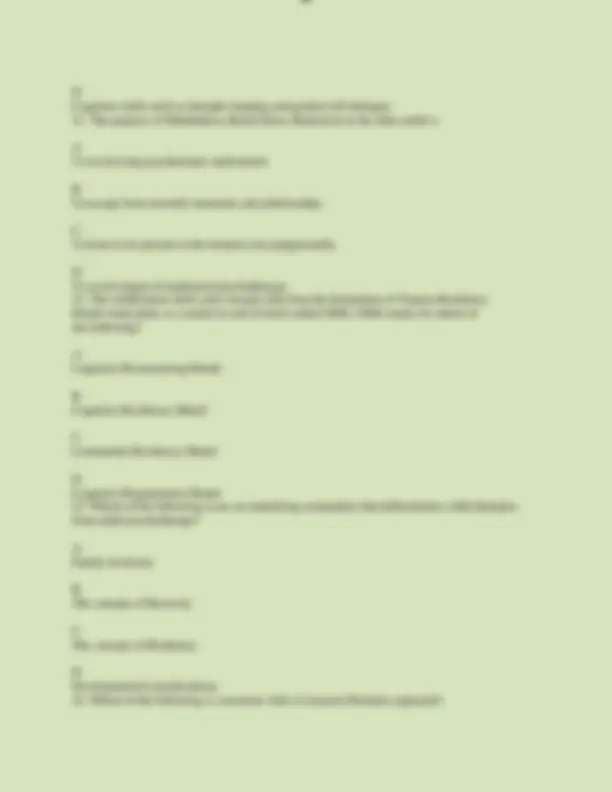
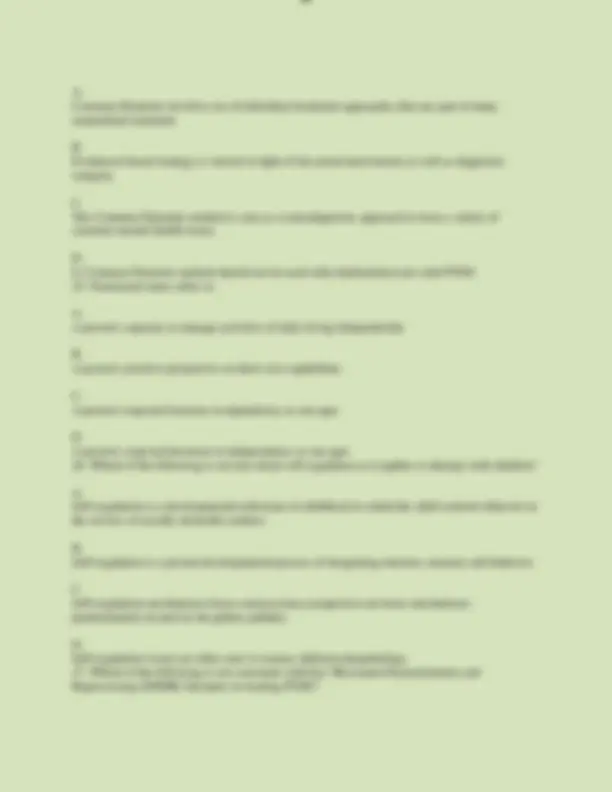
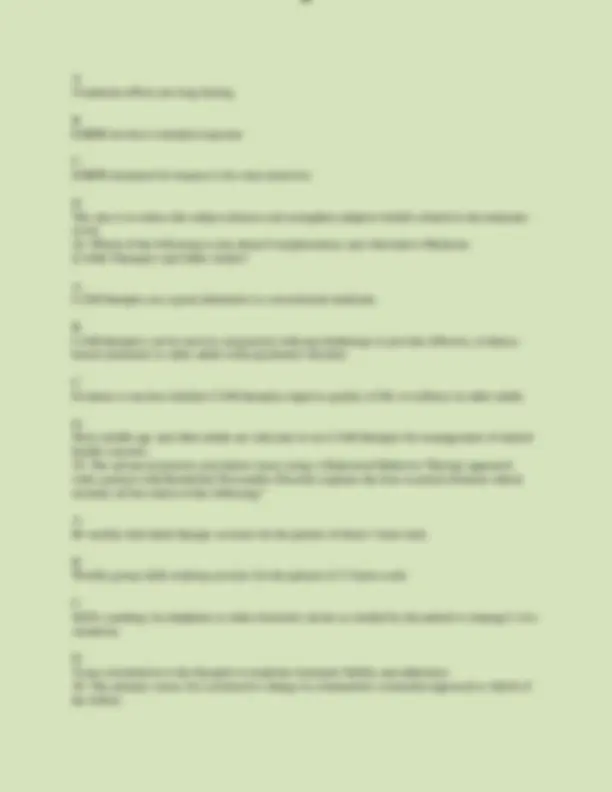
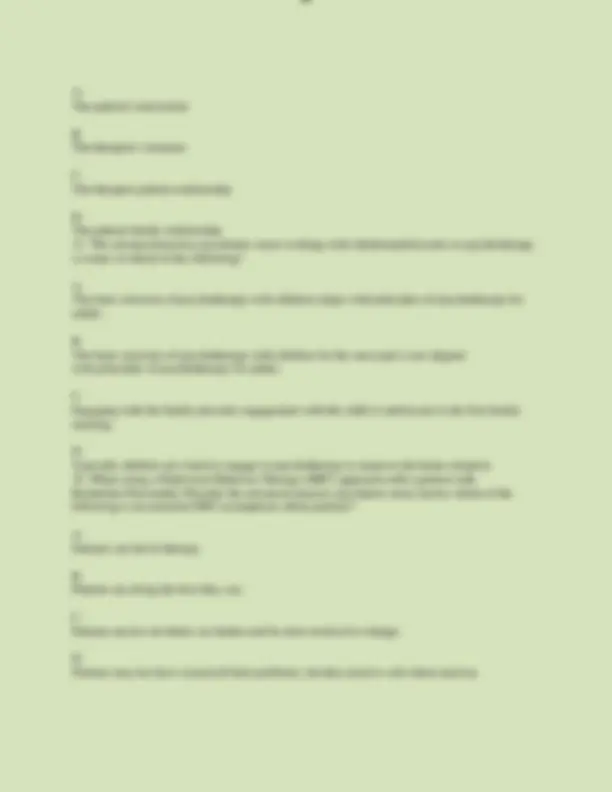
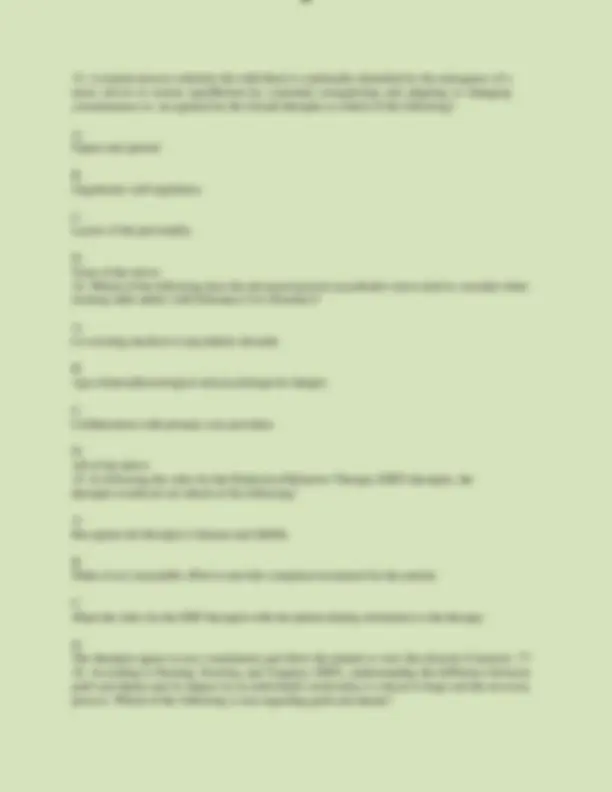
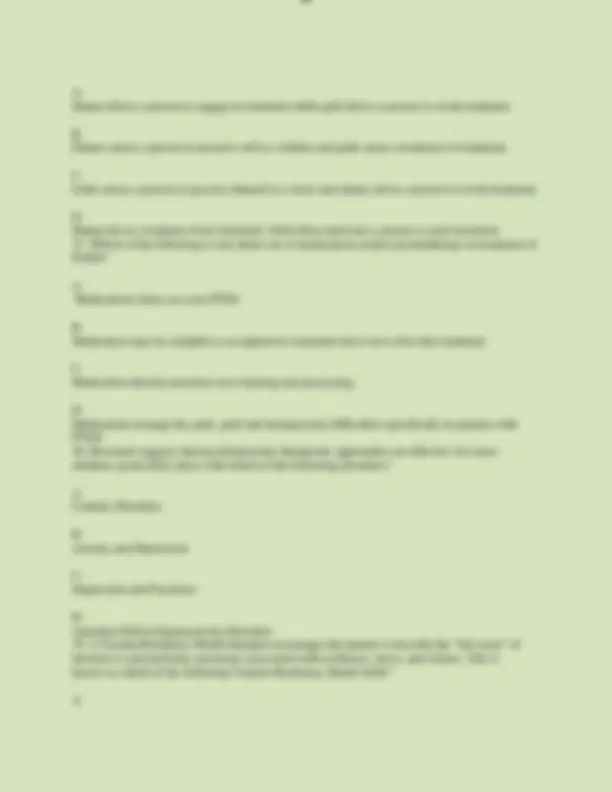
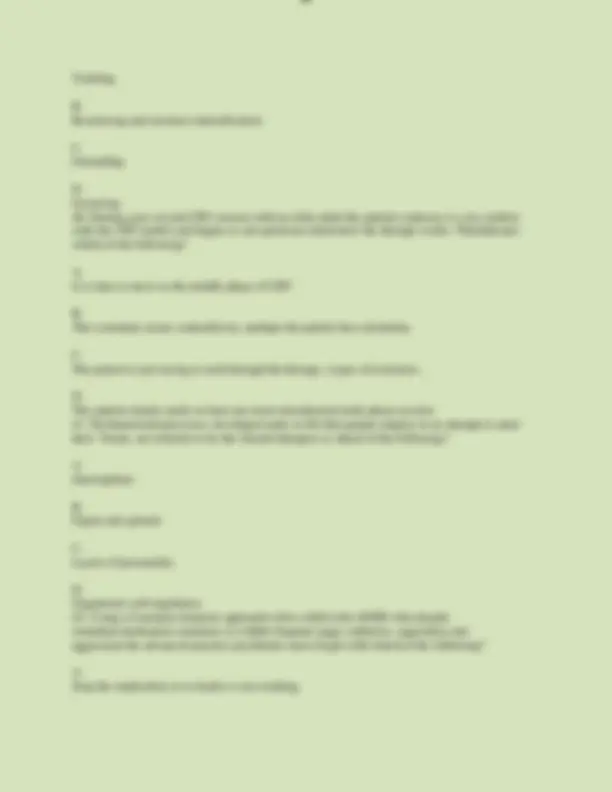
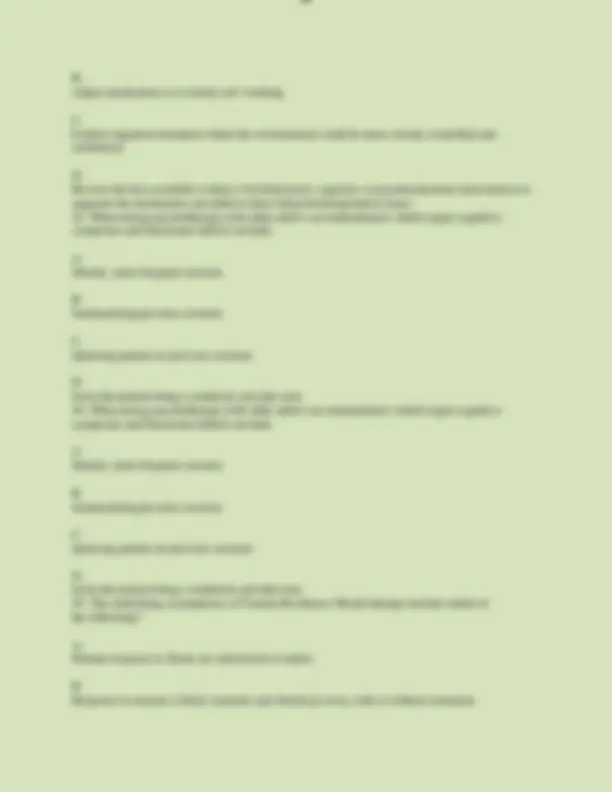
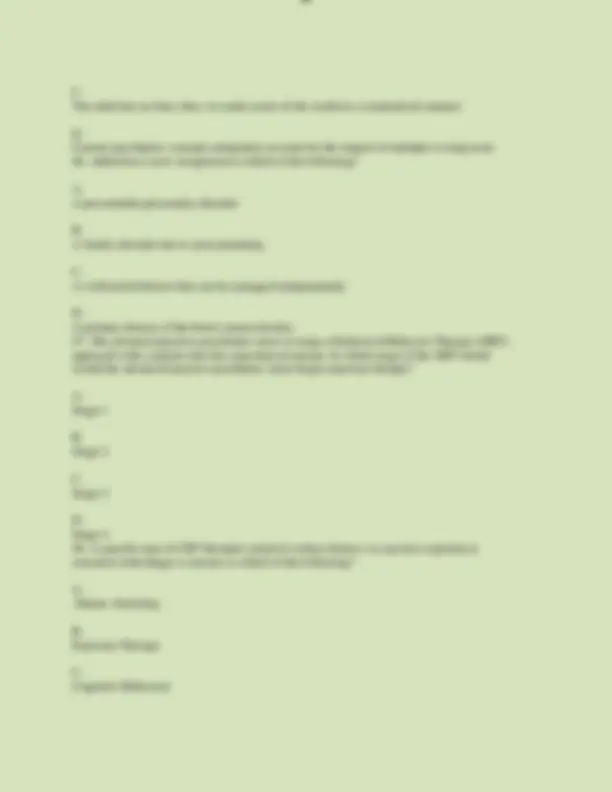
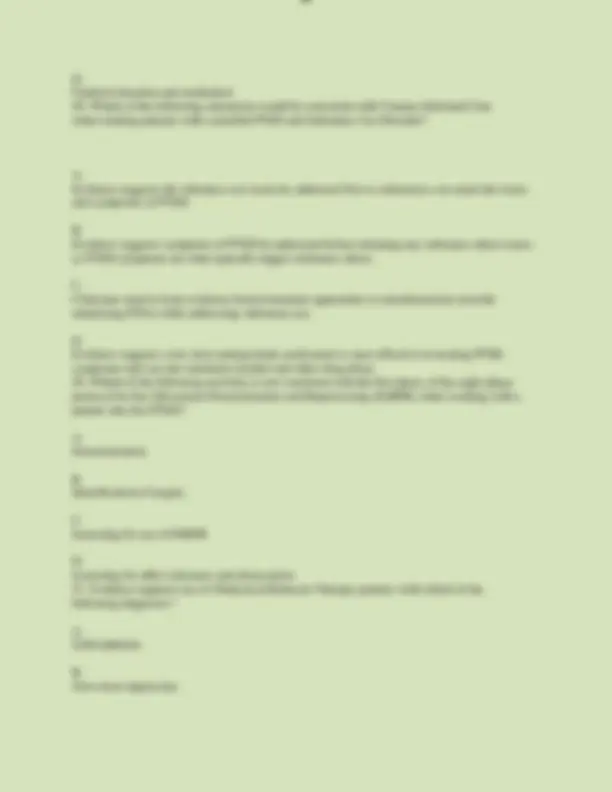
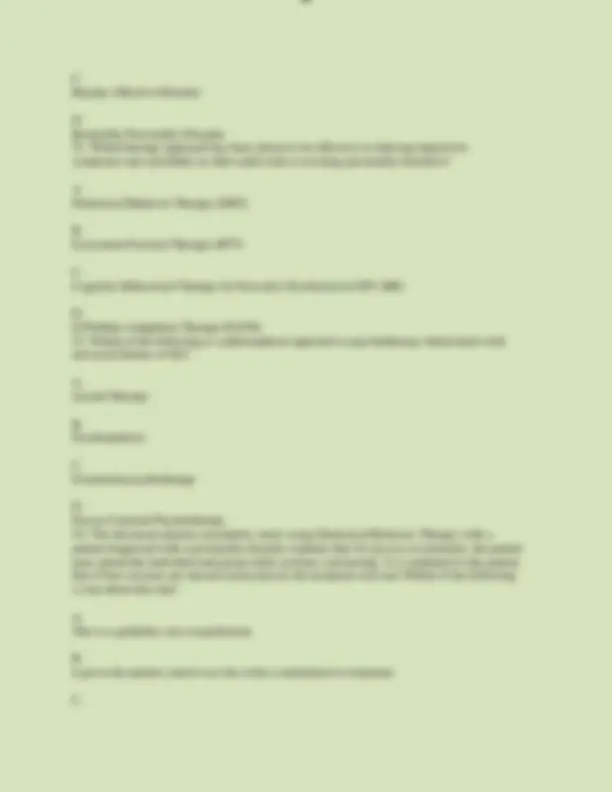
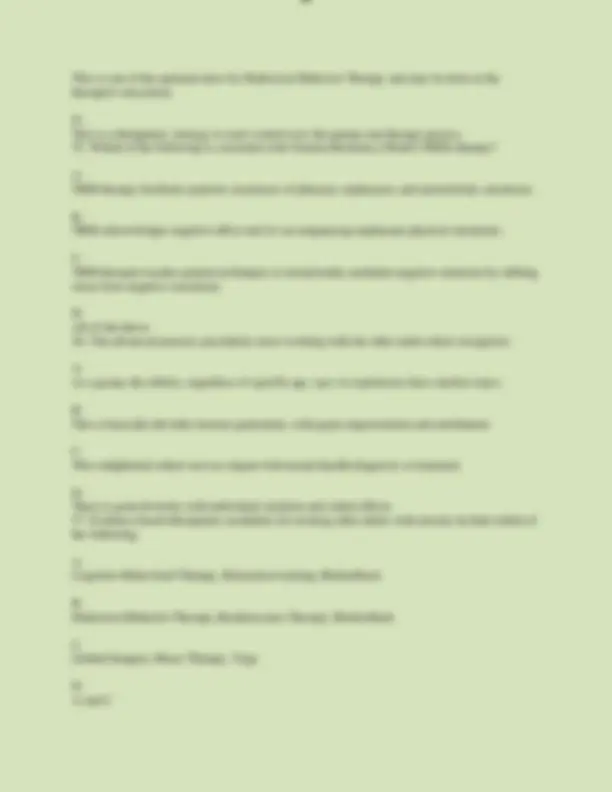
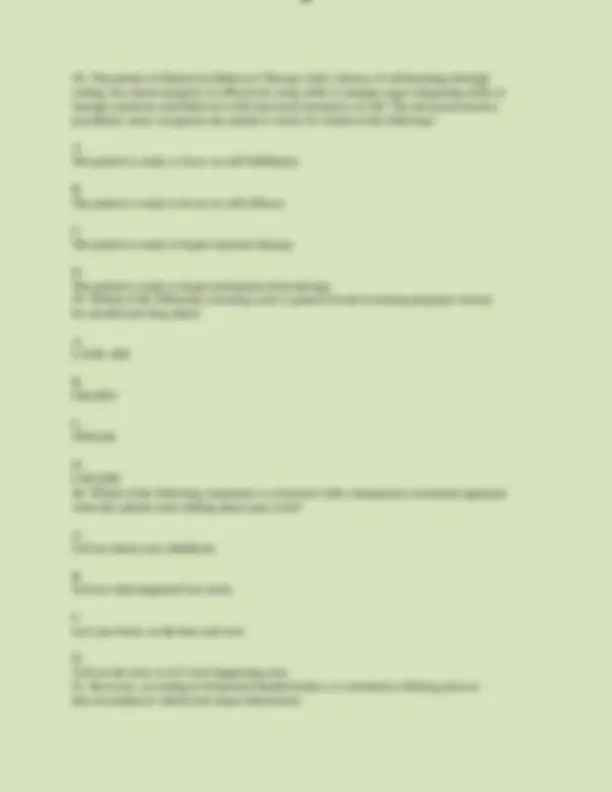
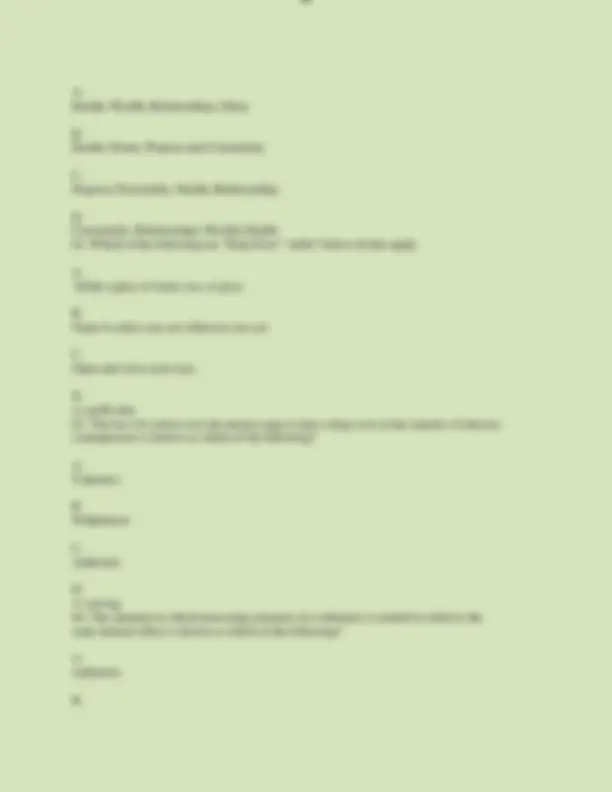
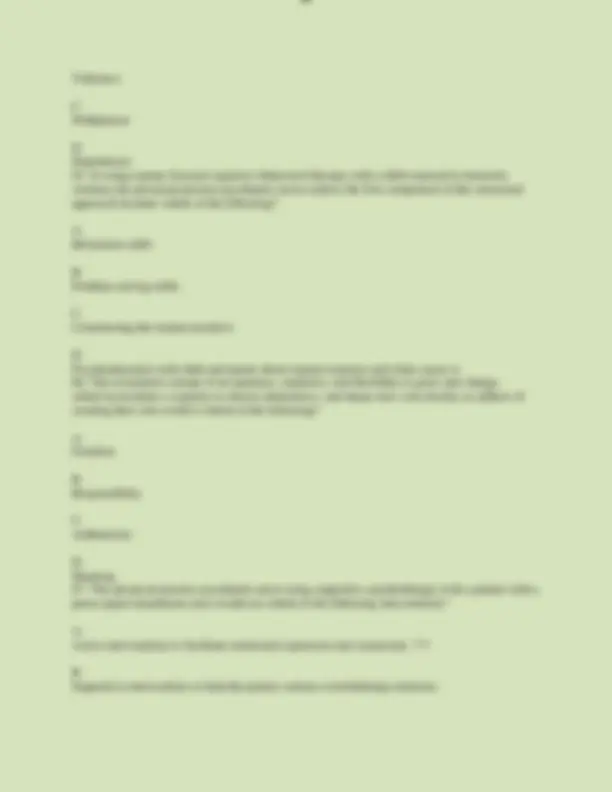
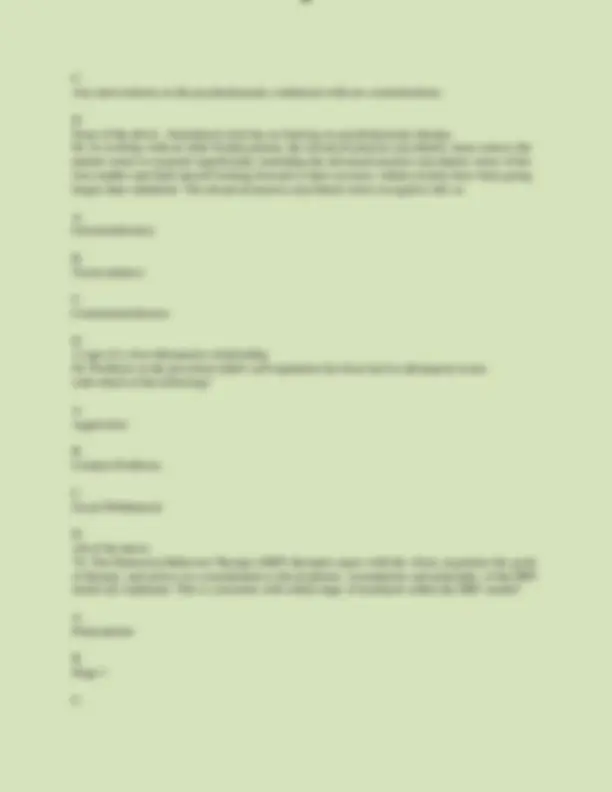
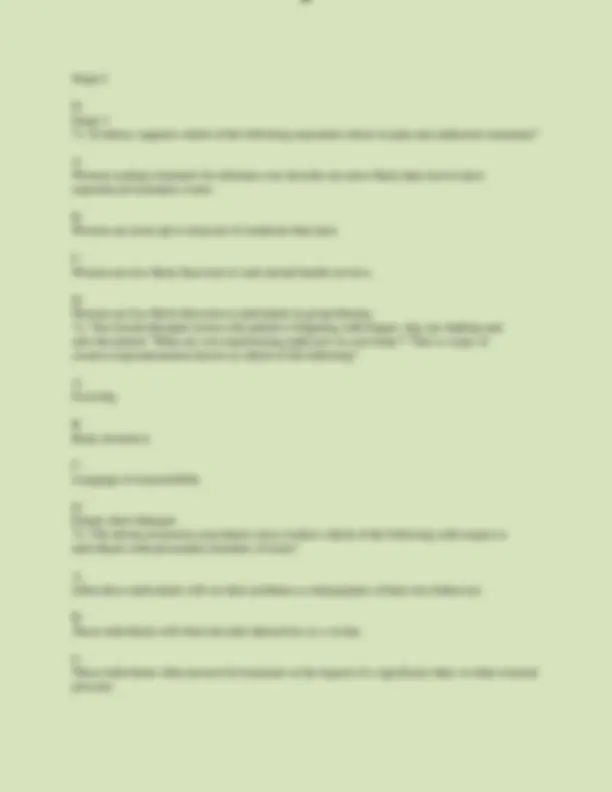
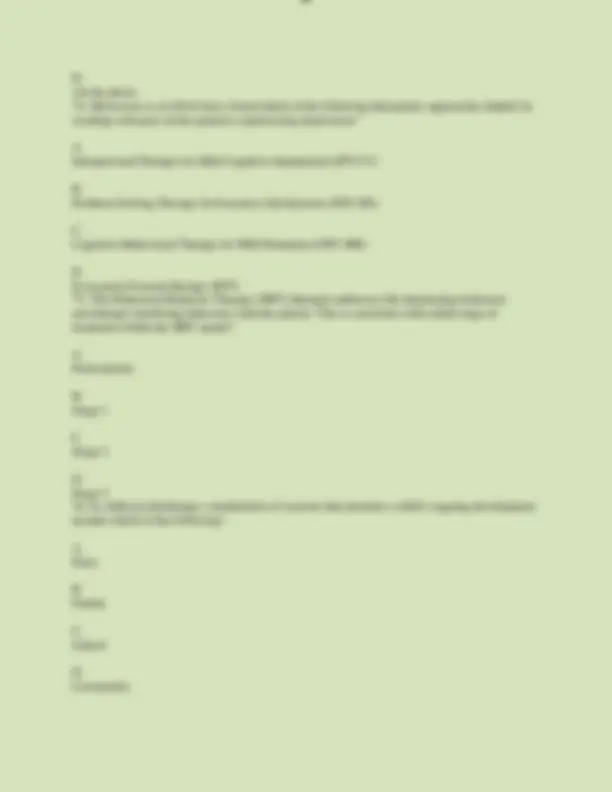
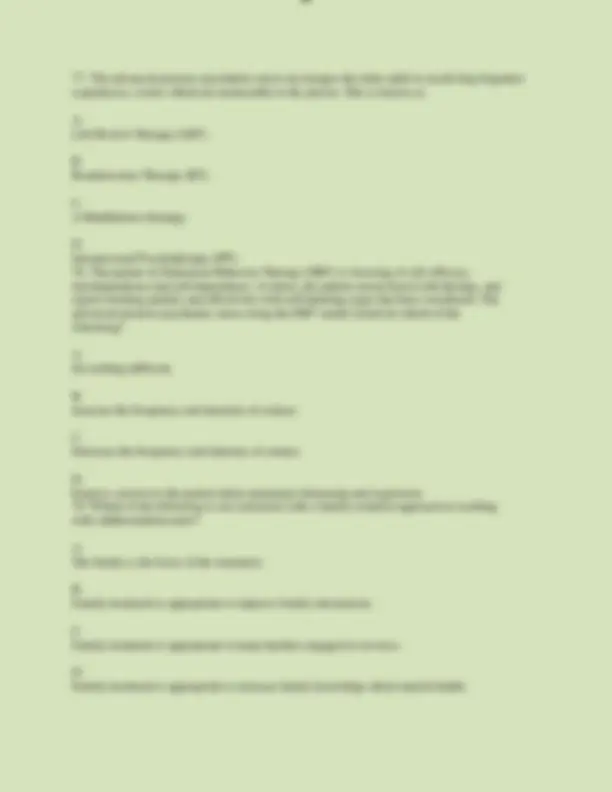
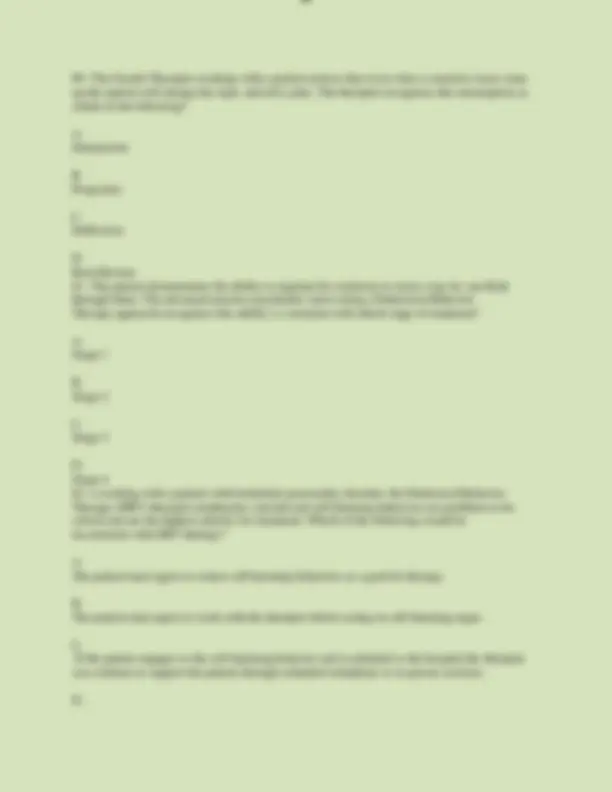
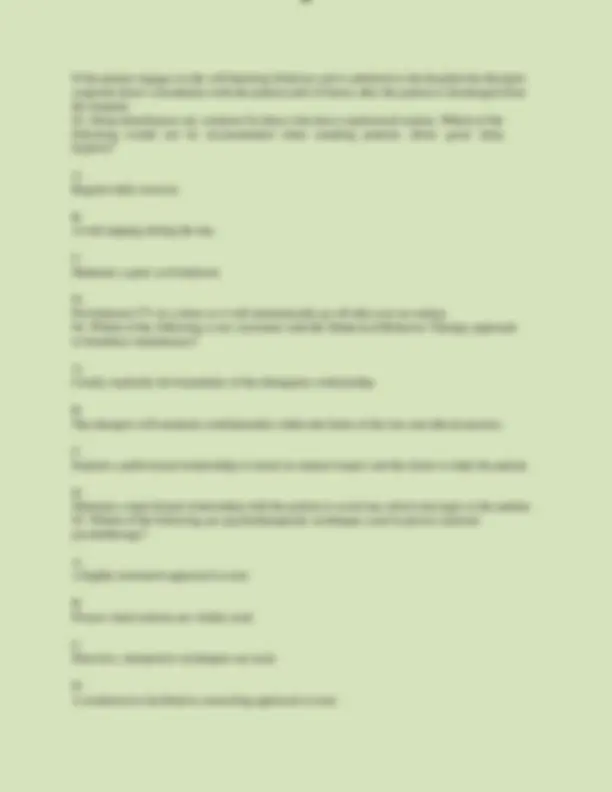
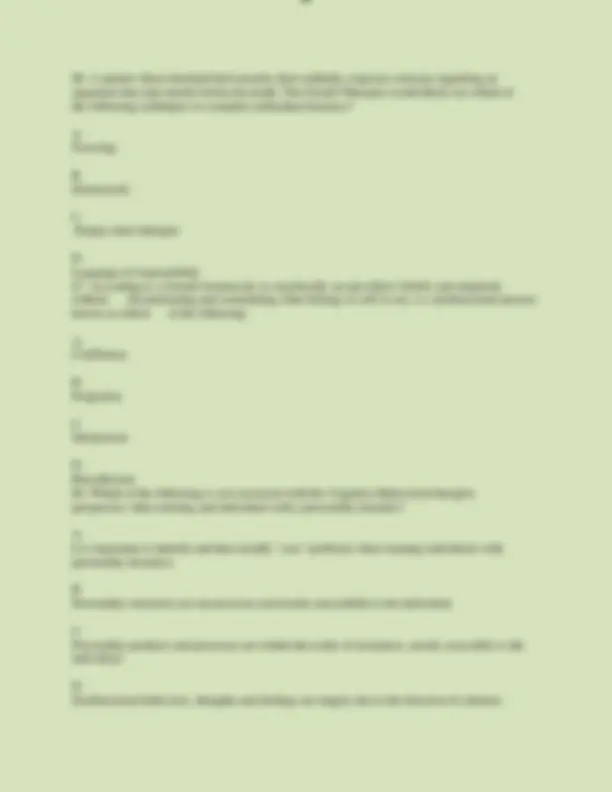
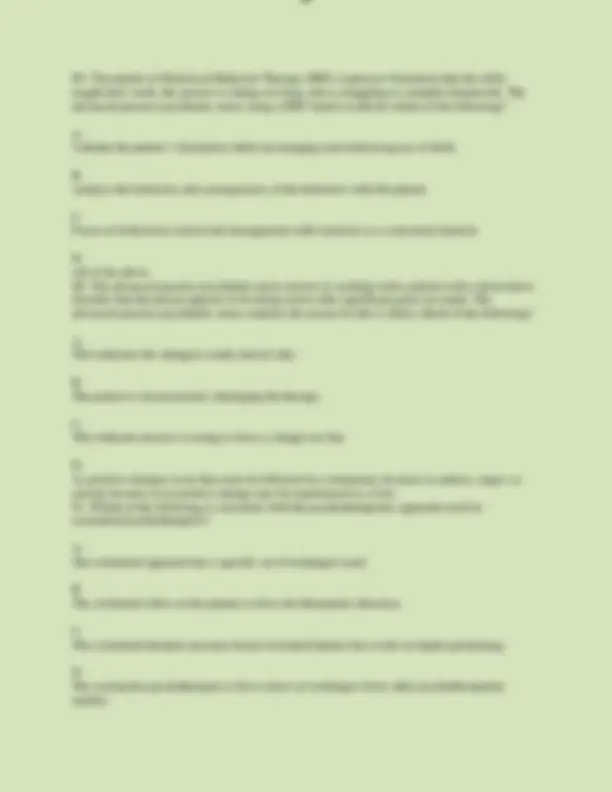
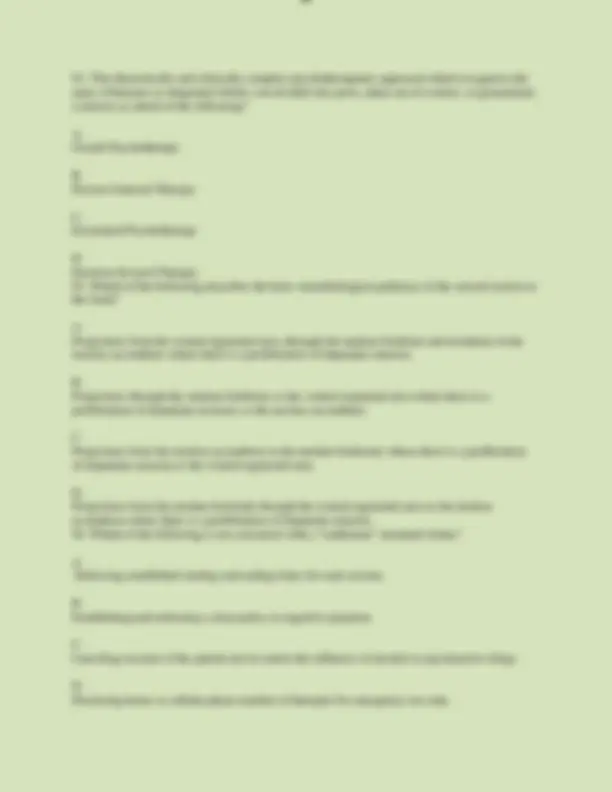
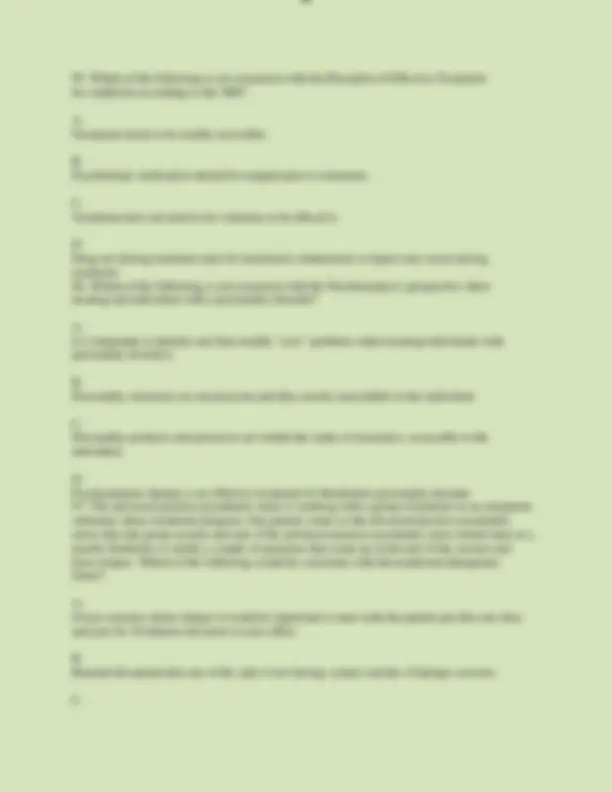
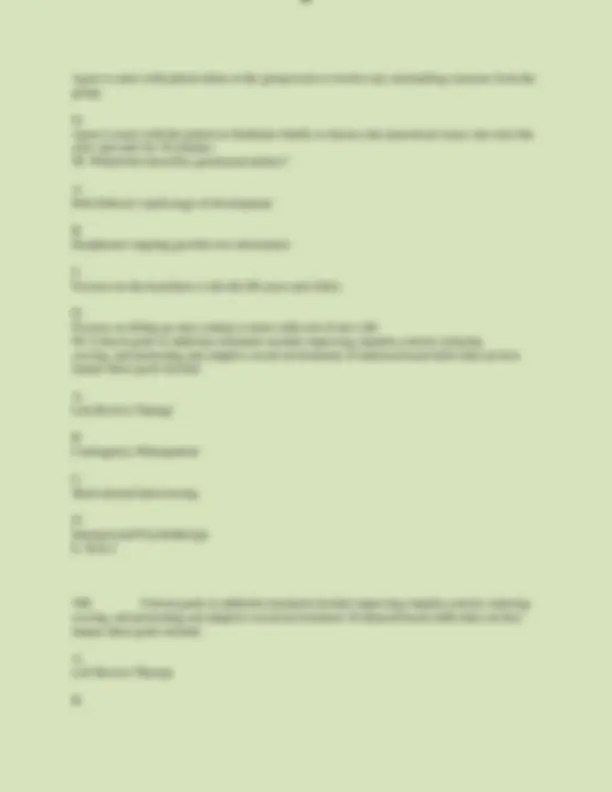


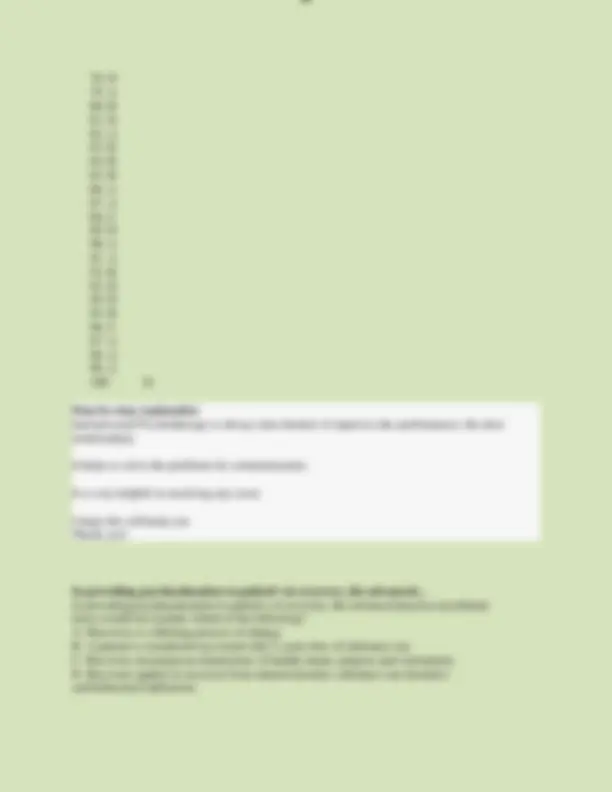
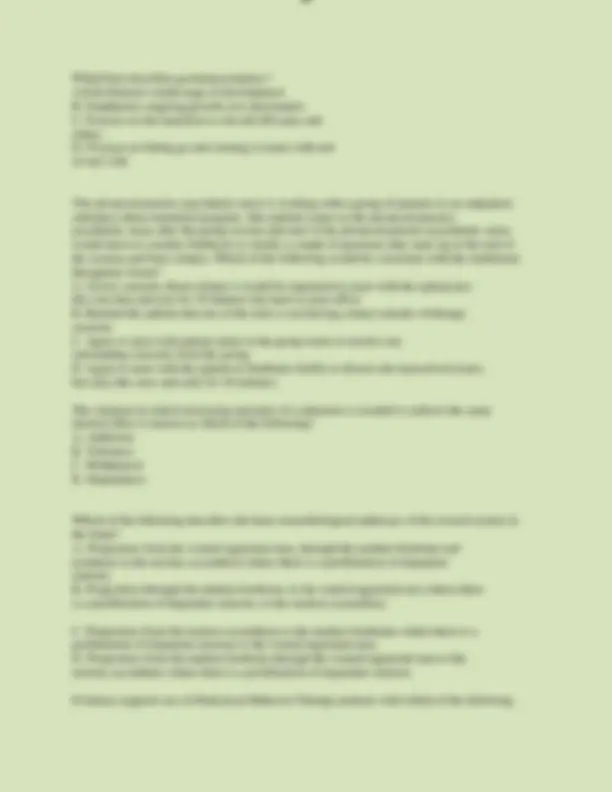
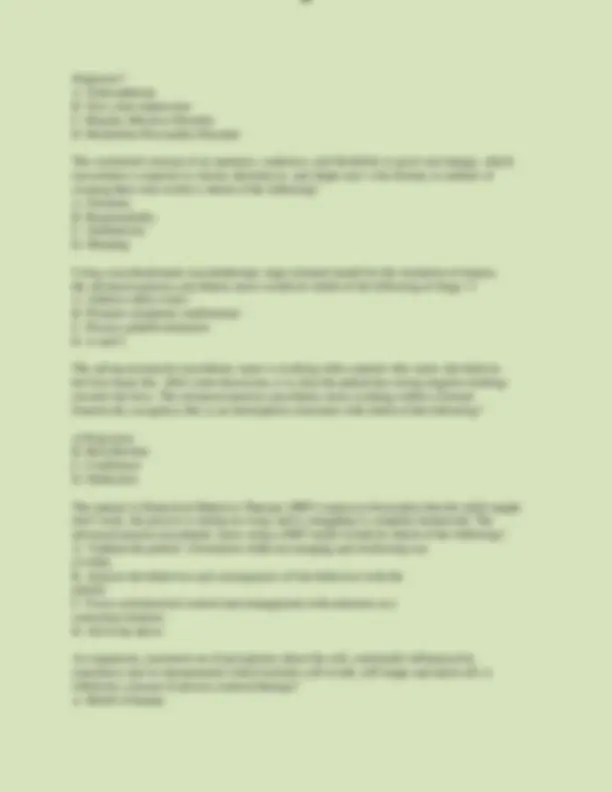
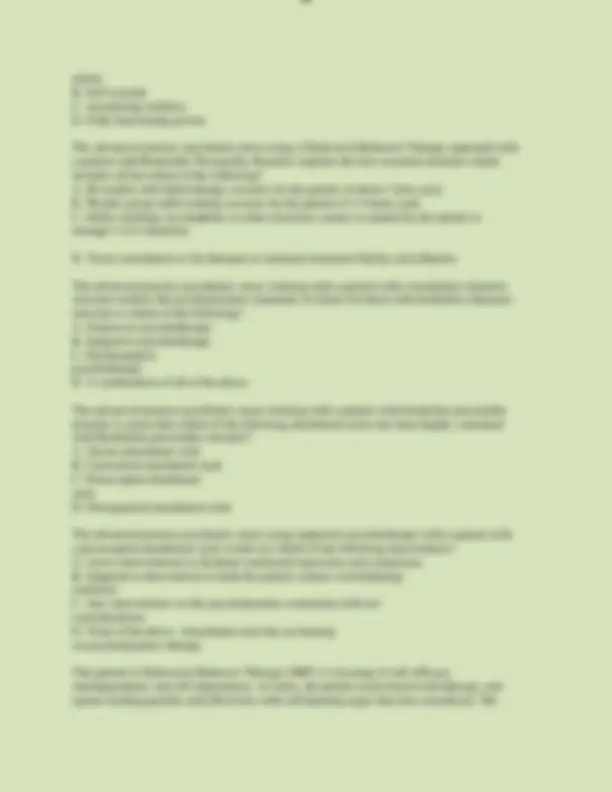
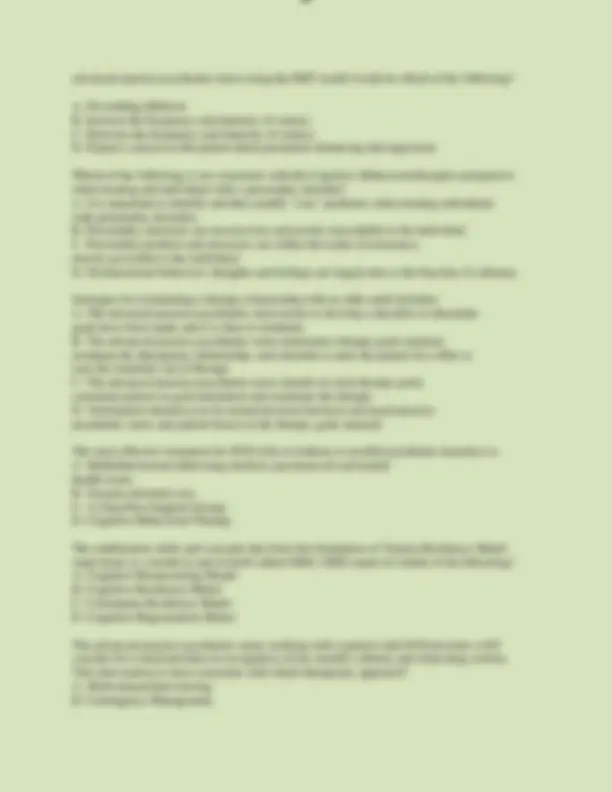
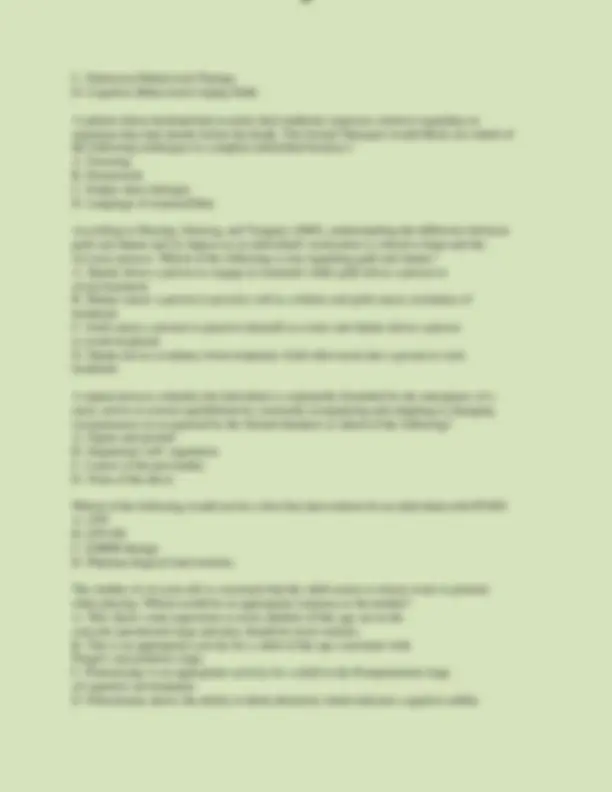
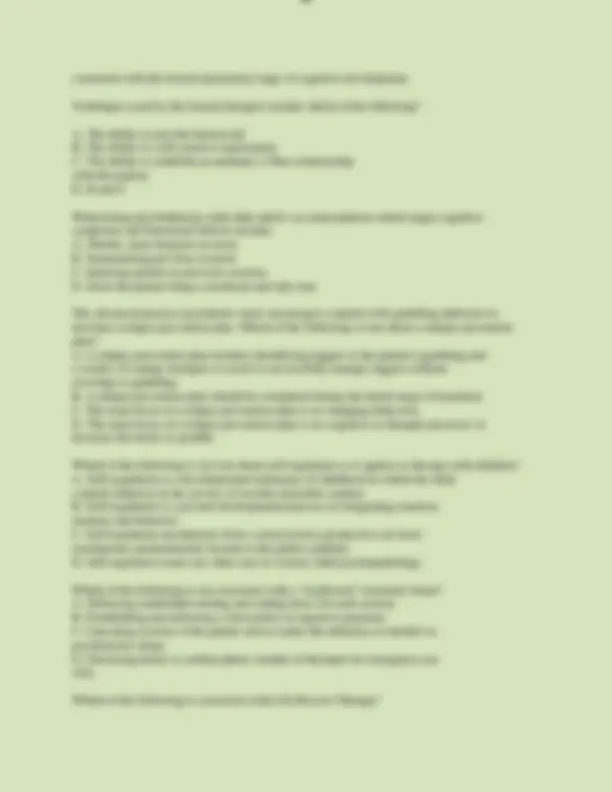
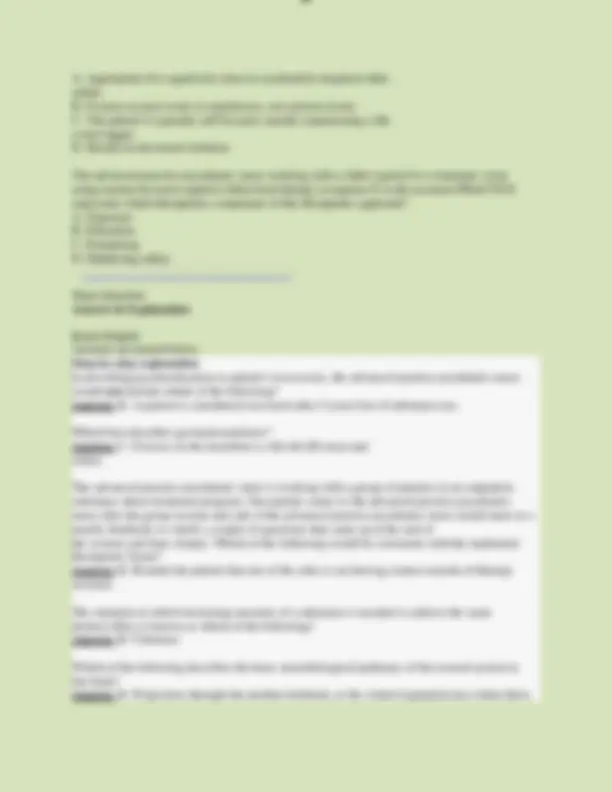
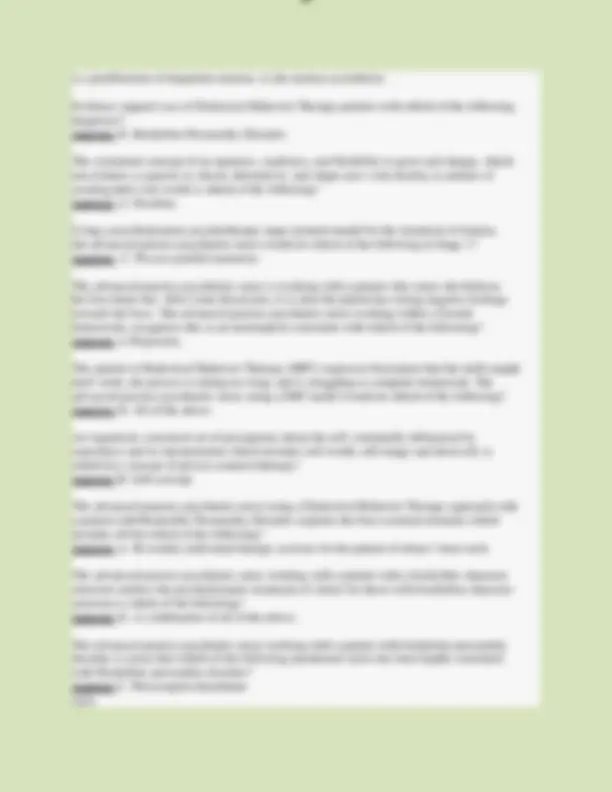
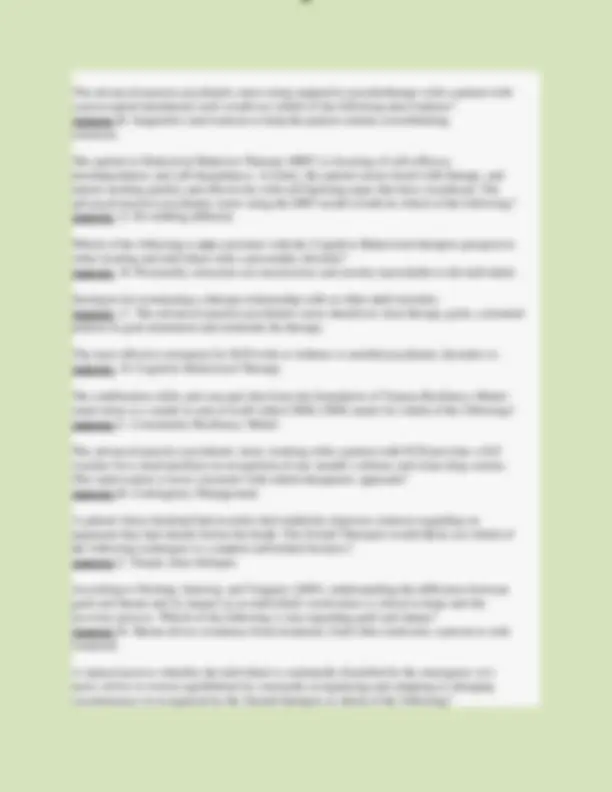
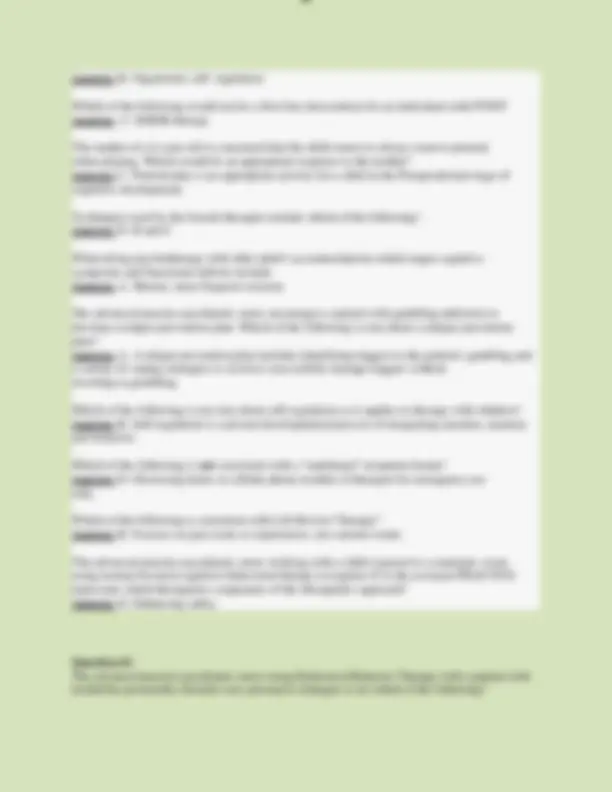
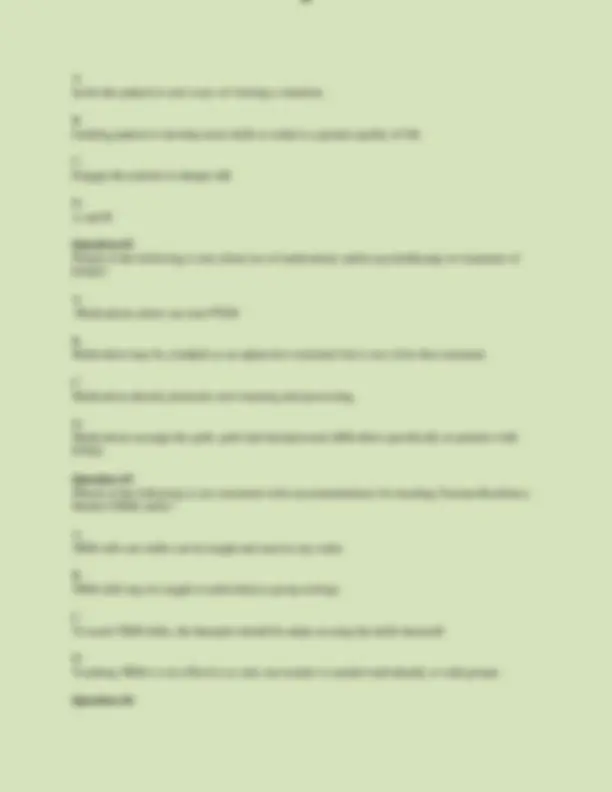
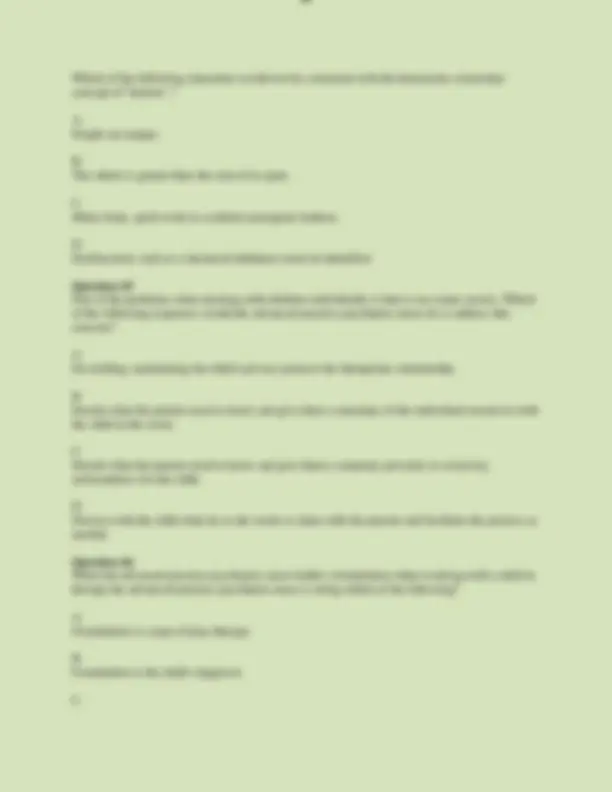
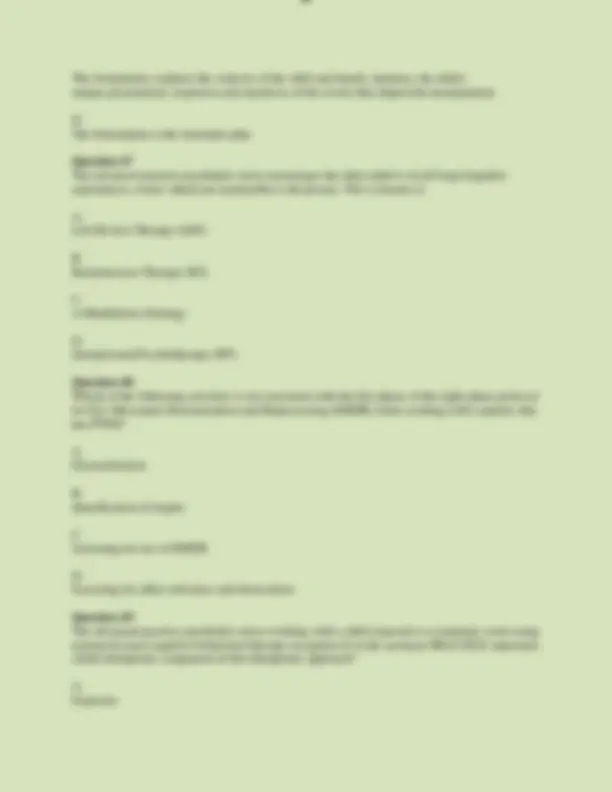
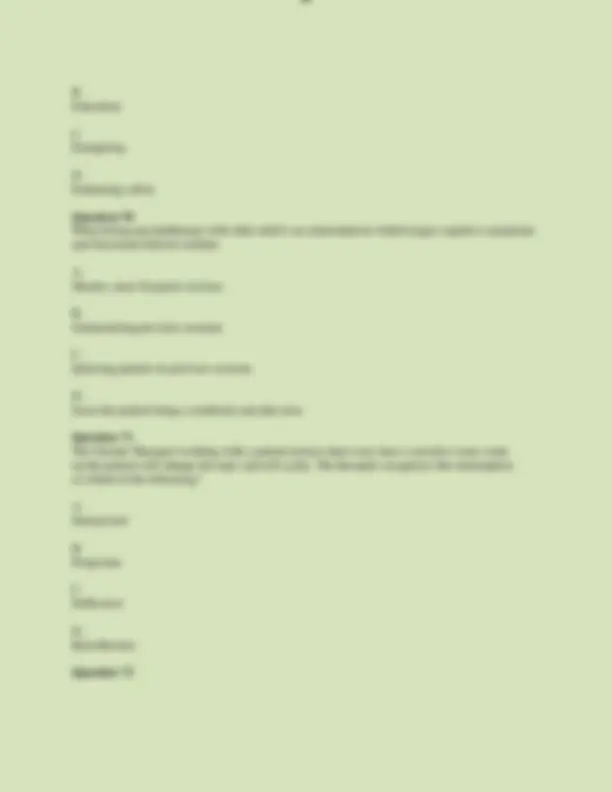
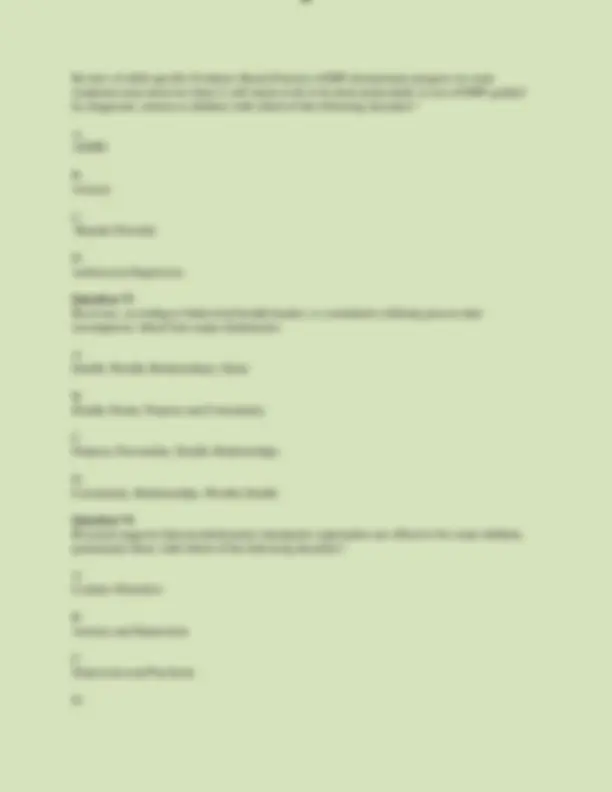
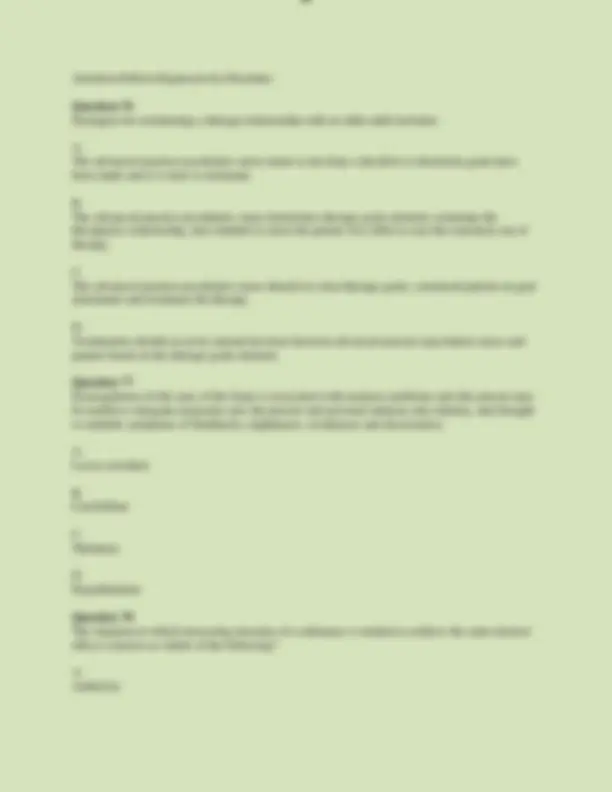
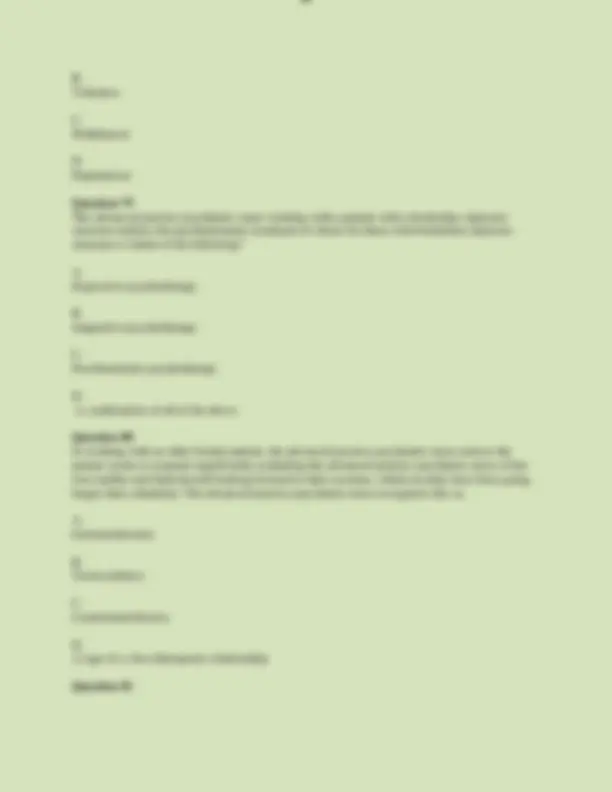
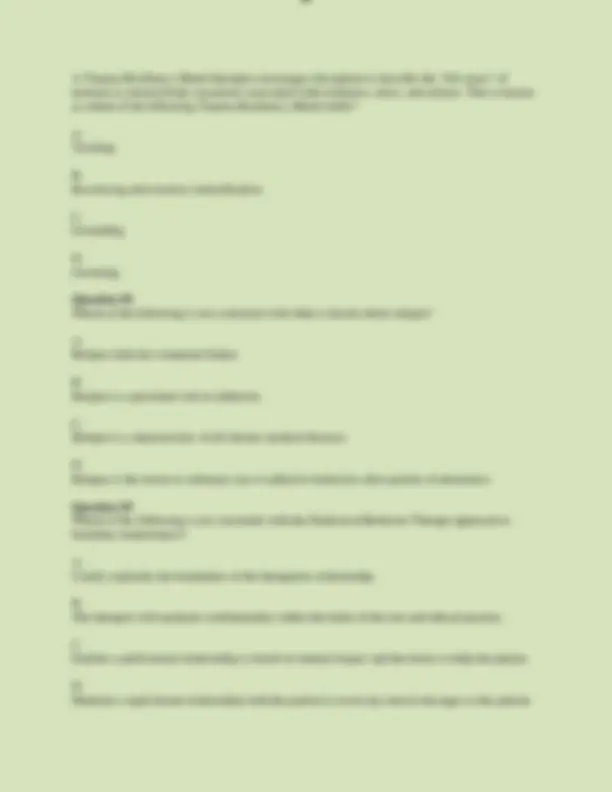
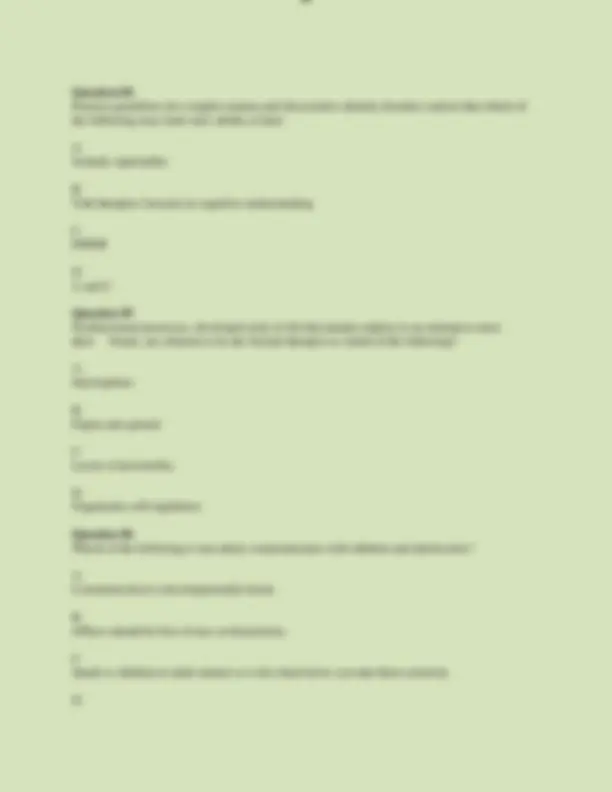
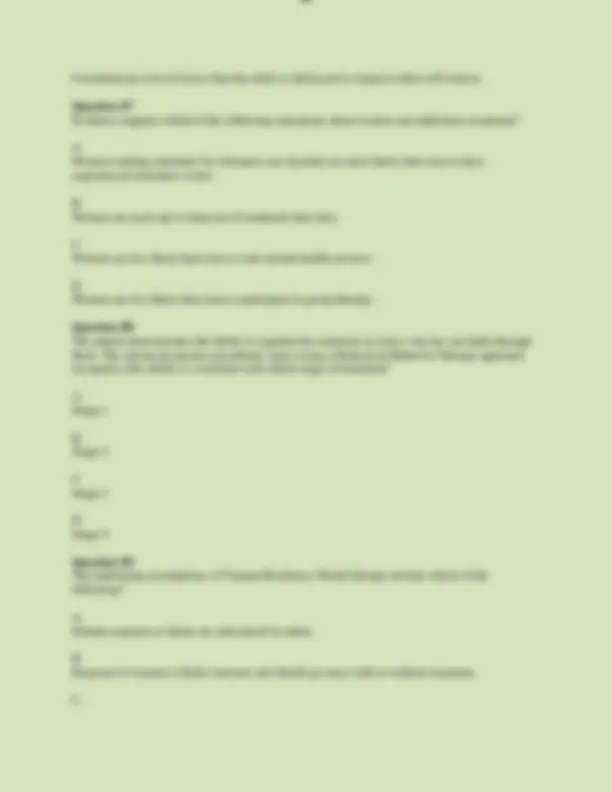
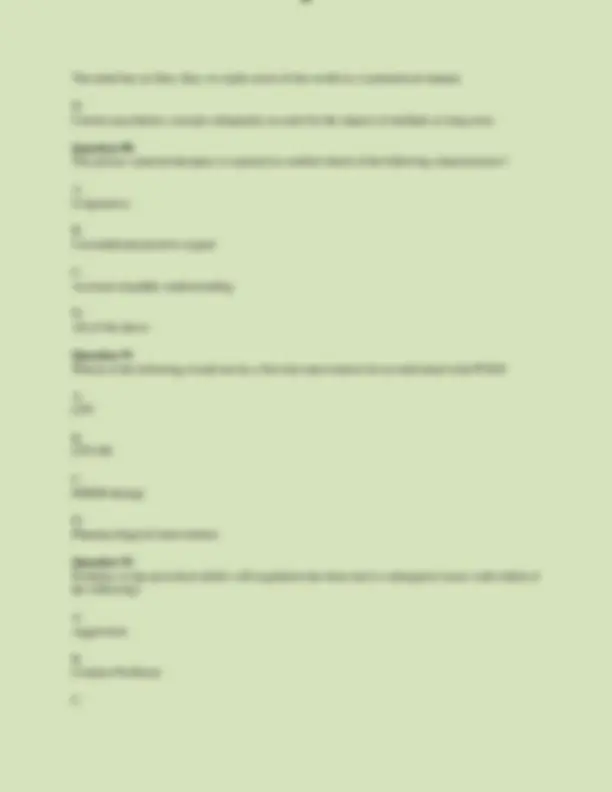
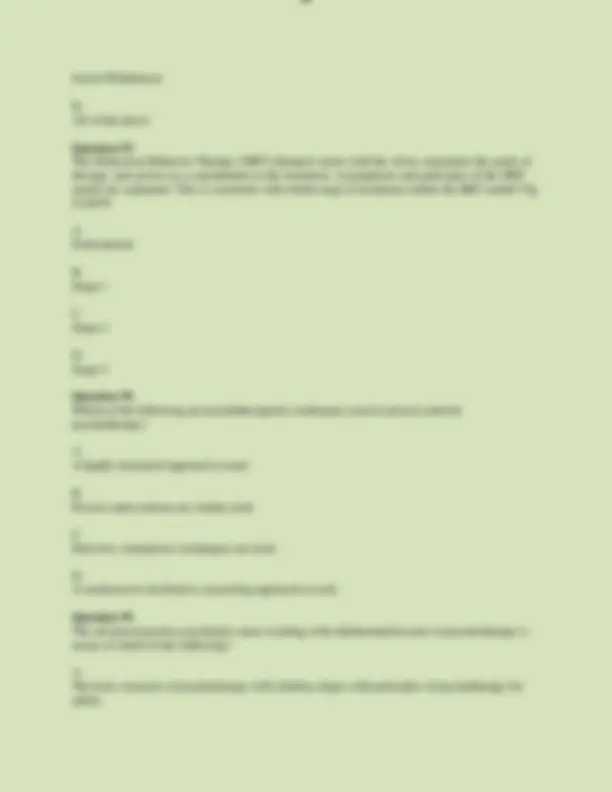
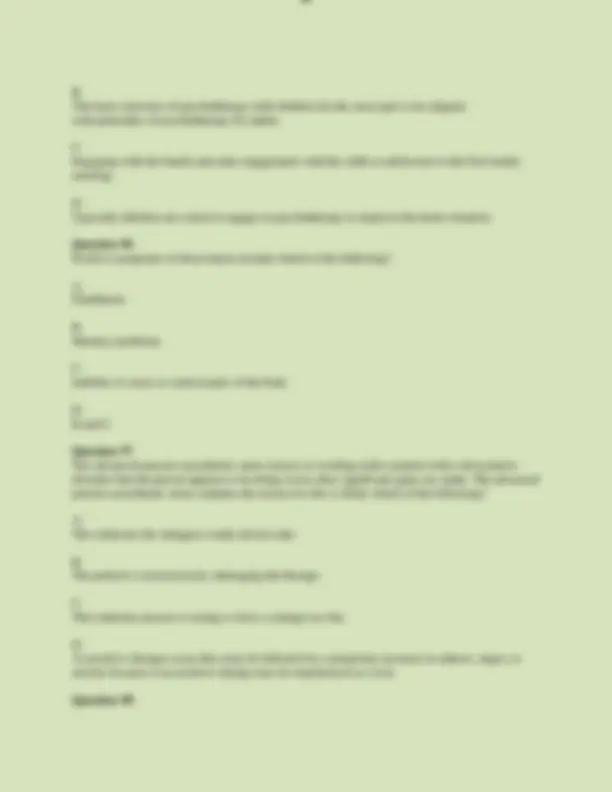
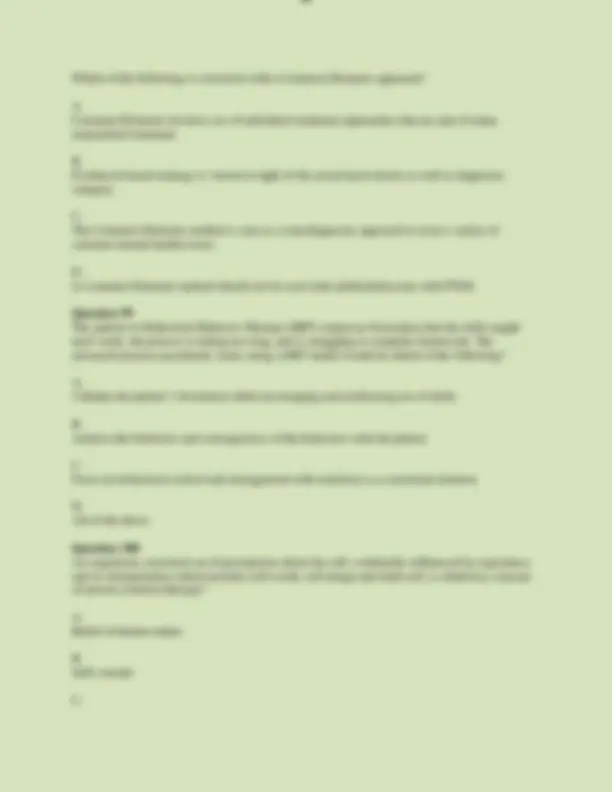
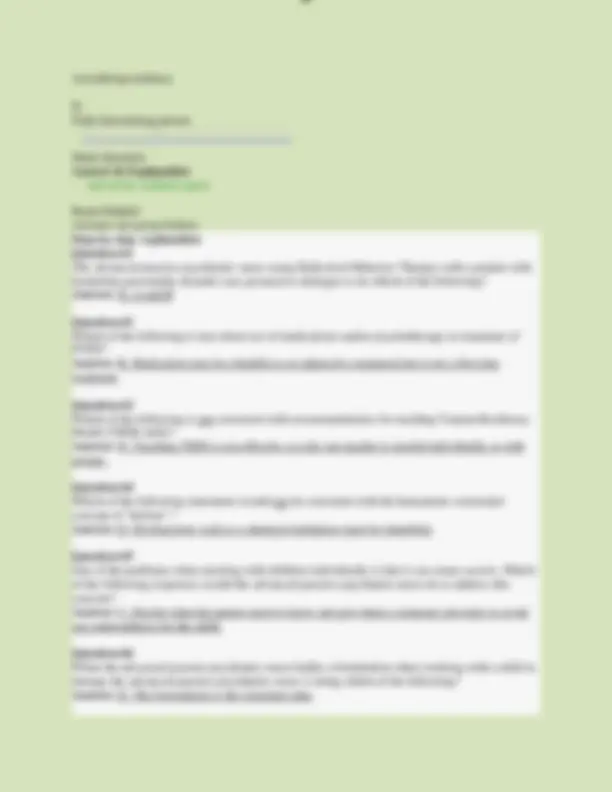
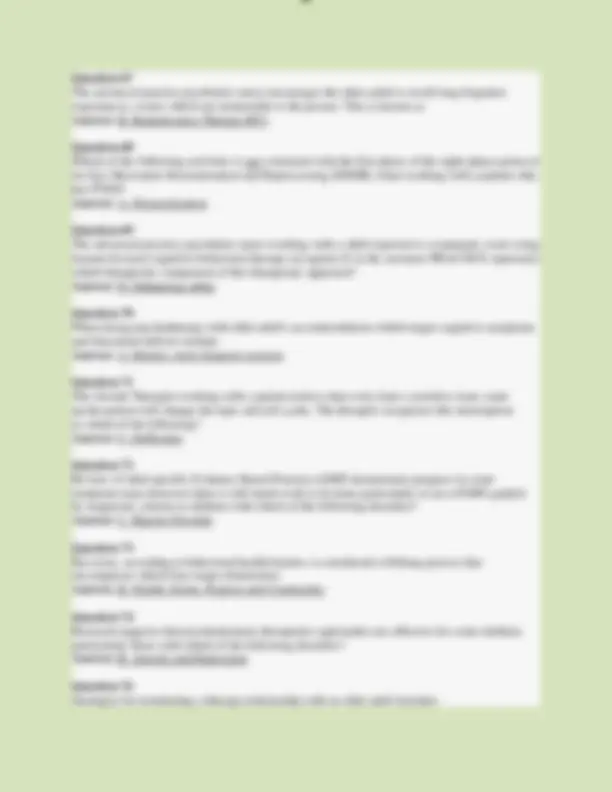
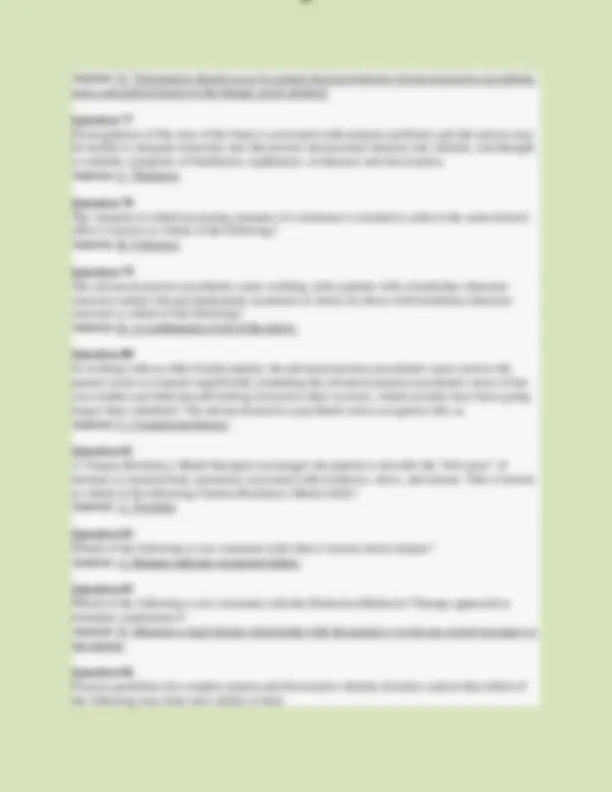
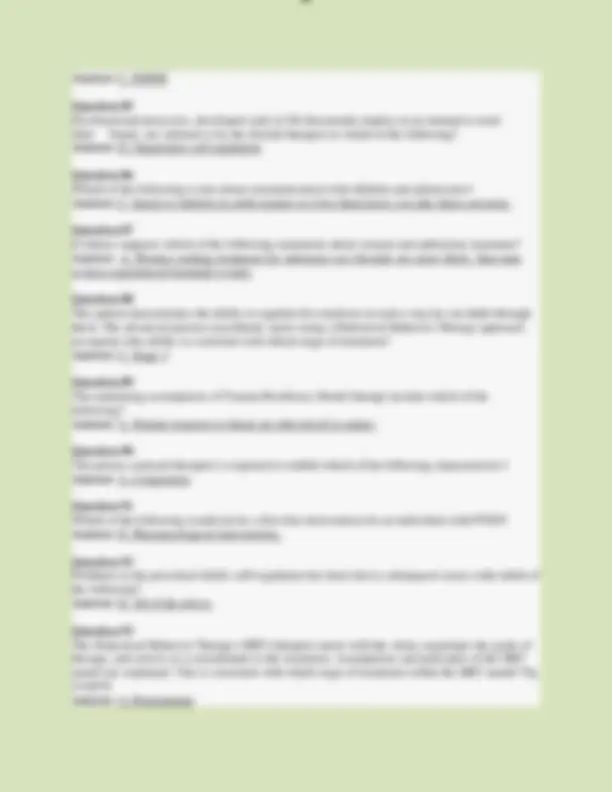
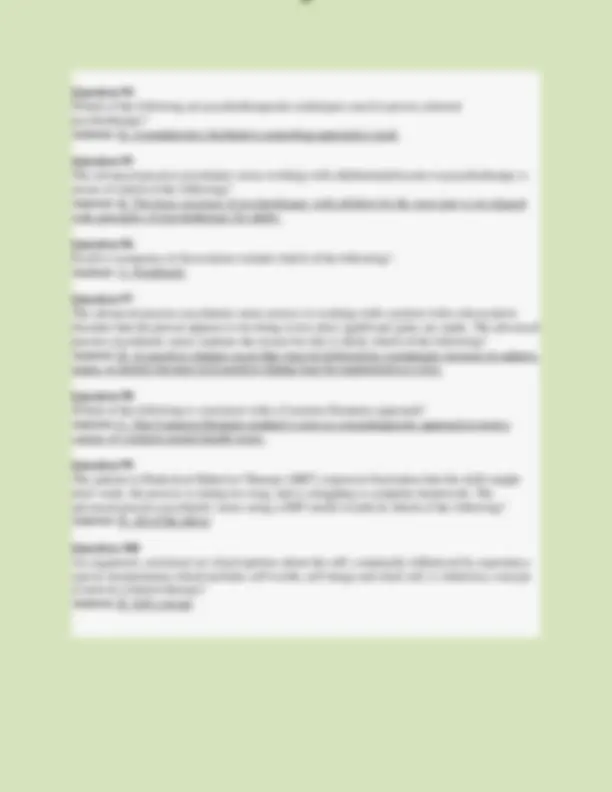



Study with the several resources on Docsity

Earn points by helping other students or get them with a premium plan


Prepare for your exams
Study with the several resources on Docsity

Earn points to download
Earn points by helping other students or get them with a premium plan
Community
Ask the community for help and clear up your study doubts
Discover the best universities in your country according to Docsity users
Free resources
Download our free guides on studying techniques, anxiety management strategies, and thesis advice from Docsity tutors
NRNP 6645 MIDTERM EXAM PSYCHOTHERAPY WITH MULTIPLE MODALITIES QUESTIONS & CORRECT ANSWERS
Typology: Exams
1 / 124

This page cannot be seen from the preview
Don't miss anything!





























































































Question 51 The novice advanced practice psychiatric nurse working as a new nurse psychotherapist may become increasingly aware of being incompetent as progress is made. According to the Stages of Learning model the advanced practice psychiatric nurse is in which stage of learning? A. Unconscious incompetency B. Conscious incompetency C. Conscious competency D. Unconscious competency Question 52 According to Freud, failure to successfully accomplish the tasks of learning independence and control is associated with which of the following problematic traits? A. Excessive dependency B. Orderliness C. Sexual identity issues D. Excessive guilt Question 53 Which of the following best describes the difference between standards of care and practice guidelines? A. Practice guidelines are legally binding while standards of care are not. B. Standards of care are legally binding while practice guidelines are not. C. There is no difference between standards of care and practice guidelines. D. Practice guidelines should be followed as written while standards of care are more flexible. Question 54 Which of the following is true about the CBT cognitive processes of primary and secondary thinking? A. Primary thinking recognizes the indeterminate, negative and irrational thinking as forever part of human action. B.
Secondary thinking recognizes the indeterminate, negative and irrational thinking as foremost. C. Primary thinking views the social and cultural world in determinate, positive and rational terms. D. B and C Question 55 According to Yalom, which of the following is consistent with the therapeutic benefit of imitative behavior? A. Imitative behavior generally plays a more important role in early stages of a group. B. Imitative behavior may allow an individual to experiment with a new behavior. C. Finding out what we are not is progress toward finding out what we are. D. All of the above Question 56 Patients who would not be considered ideal candidates for psychoanalytic psychotherapy are which of the following? A. Patients with primarily primitive defenses B. Patients with primarily mature defense mechanisms C. Patients with neurotic to healthy personality organization. D. Patients with the capability to engage in a therapeutic alliance Question 57 During the initial contact with an individual seeking family therapy it is important for the family therapist to: A. Identify the presenting problem and arrange a consultation with everyone living in the family household. B. Identify the presenting problem and arrange a consultation with the caller to ensure family therapy is really necessary. C. Identify the presenting problem and arrange to meet with the caller and the family member that is creating most of the problem. D. Identify the presenting problem and arrange a consultation with the parents of the family to develop a therapeutic alliance and strategy for fixing the problem. Question 58
Manipulate the environment D. Maximize adaptive coping mechanisms Question 62 What distinguishes psychoanalytic therapy from other types of therapies? A. The focus on problem-solving B. The focus on irrational thoughts C. The focus on dreams and wishes D. The deep analysis of the patient relationship with the therapist. Question 63 The idea that nothing happens by chance, that every thought and all behavior has a cause refers to which of the following concepts? A. Id vs ego conflict B. Super ego actions to censor and restrain C. Psychic determinism D. Ego synchrony Question 64 In supportive psychodynamic psychotherapy the content of the sessions most often focuses on which of the following? A. Feelings and defenses B. Life stresses and feelings C. Life stresses and problem-solving D. B and C Question 65 Which of the following is consistent with use of direct advice as a strategy of imparting of information? A. Specific advice-giving supports intimate group engagement. B. The most effective form of direct advice is direct suggestion. C.
Direct advice is often an important clue in elucidation of interpersonal pathology in the group. D. The least effective form of direct advice was a series of alternative suggestion for goal achievement. Question 66 The advanced practice psychiatric nurse solution focused therapy with a family will do which of the following? A. Focus on the etiology of the problem B. Focus on problem formation C. Clearly define the problem for the family and then focus on potential solutions for the family. D. Help the family amplify exceptions to their problem and recognize effective solutions already in their repertoire. Question 67 Which of the following is not consistent with clinical practice guidelines for use of psychodynamic therapy for various psychiatric disorders? A. Panic-focused psychodynamic psychotherapy is recommended as an initial treatment for Panic Disorder B. No RCTs support use of psychodynamic therapy for Obsessive-Compulsive Disorder. C. Psychodynamic therapy is considered a first-line treatment for Schizophrenia D. Psychodynamic therapy is a therapeutic treatment option for Major Depressive Disorder. Question 68 It is important for the new nurse psychotherapist to become comfortable with which of the following? A. Learning to be directive to help the patient feel better. B. Letting the psychotherapeutic process unfold over time. C. Helping the patient feel better is the main goal of psychotherapy D. Building a therapeutic toolbox for a variety of "fix it" solutions for a variety of problems. Question 69
Biological events cause human actions. C. One can learn to activate their prefrontal cortex and retrain emotional reactions. D. Biological events always over-rides free will. Question 73 Psychodynamic psychotherapy interventions focus on which of the following? A. The person's thoughts beliefs and behaviors B. The person's relationships and family dynamics C. The person's emotions and thoughts, deepening understanding of triggers form the past played out in the present. D. The person's body, beliefs, images, and emotions to process trauma Question 74 The change agent in relational psychodynamic therapy is which of the following? A. Insight B. Interpretation of past experiences C. Exploration of genetic roots of the problem D. Mindfulnes Question 75 A group of co-occurring, relatively invariant symptoms found in a specific cultural group, community or context, which may or may not be recognized as an illness within the culture but such cultural patterns of distress and features of illness may be recognizable by the outside observer is known as which of the following? A. Cultural syndrome B. Cultural formulation C. Cultural idiom of distress D. Cultural explanation or perceived cause Question 76
A group member becomes angry with the group leader accusing the leader of being too controlling and showing favoritism. This behavior is consistent with which of Yalom's therapeutic factors? A. Catharsis B. Interpersonal learning C. Development of socializing techniques D. The corrective recapitulation of the primary family group Question 77 Role play in the context of the therapy session is an example of which of the following behavioral techniques: A. Bibliotherapy B. Behavioral rehearsal C. Contingency management D. Cognitive restructuring Question 78 The advanced practice psychiatric nurse who assists the patient to maintain eye contact appropriately, shaking hands appropriately, appropriate language in public is doing which of the following? A. Social Skills Training B. Shame-Attacking Exercises C. Guided Contingency Management D. Examining Options and Alternatives Question 79 "If I was in a relationship, all of my problems would be solved" is an example of which type of cognitive distortion? A. Fallacy of attachment B. Fallacy of worrying C. Fallacy of perfect effect D.
Accepting new members into the system. D. Accepting emotional and financial responsibility for self. Question 84 Which of the following is not consistent with current research related to psychotherapy and psychotropic medication? A. Research suggests that psychotherapy enhances the effects of psychotropic medication. B. Studies comparing medication with psychotherapy found both produce similar physiological changes in the brain. C. Studies comparing medication with psychotherapy found both produce physiological changes but brain changes are different for medications than for psychotherapy. D. Research suggests psychotropic medications may interfere with the learning that takes place during psychotherapy. Question 85 The concept that reminds us that families are open systems, and our interpretations are shaped by assumptions we absorb from the culture is known as: A. Constructivism B. Systems Theory C. Attachment Theory D. Social Constructionism Question 86 Which of the following is not consistent with therapeutic process of the corrective recapitulation of the primary family group in group psychotherapy? A. The therapeutic value is that early familial conflicts are simply relived. B. The therapeutic value is that early familial conflicts are relived correctively. C. Fixed roles must be constantly explored and challenged. D. Working out problems in the group setting is also working through unfinished business from long ago. Question 87 According to Mahler's stages of separation-individuation the phase of "normal autism" occurs during what age range? A. Birth to 1 month
10 to 16 months C. 16 to 24 months D. 24 to 36 months Question 88 During the middle phase of family therapy treatment much of the treatment is devoted to which of the following: A. Identifying major conflicts and focusing on structures that perpetuate them. B. The therapist serving as a conduit for most of the communication to keep conflict at a minimum during the session. C. Helping the family members to deal more constructively with each other in the sessions. D. Preventing family members from feeling anxiety as they are working through their issues. Question 89 According to Benner's role acquisition model, the advanced practice psychiatric nurse with 2 - 5 years of experience, who coordinates complex care and sees situations as wholes with long-term solutions, is functioning at which level of competency? A. Novice B. Advanced beginner C. Competency/proficiency D. Expert Question 90 In relational psychodynamic psychotherapy the therapist helps the patient with which of the following? A. To understand the patient's impact on others. B. To deepen the patient's understanding of others. C. Both A and B D. Neither A nor B is consistent with the focus of relational psychodynamic psychotherapy. Question 91 Cross-cultural research supports which of the following? A. Culture determines what is considered a psychiatric disorder
3 years to 6 years C. 6 years to 12 years D. 13 years to 20 years Question 96 Yalom states the group therapy analogue to relationship in individual therapy is which of the following? A. Universality B. Cohesiveness C. Social microcosm D. The corrective emotional experience Question 97 Hildegard Peplau developed the psychodynamic interpersonal model for psychiatric nursing based on which theorist's framework? A. Eric Erickson B. Sigmund Freud C. Margaret Mahler D. Harry Stack Sullivan Question 98 A patient involved in expressive psychotherapy is having intense emotional reactions to painful experiences that have been expressed. This is known as which of the following? A. Immediacy B. Abreaction C. Differentiation D. Rapprochement Question 99 According to Minuchin two patterns common to troubled families are: A. Victims and rescuers B. Entitlement and indebtedness
Enmeshed and disengaged D. Leaders and followers Question 100 A patient being treated with supportive psychodynamic psychotherapy has been missing sessions and coming late when coming to sessions. The advanced practice psychiatric nurse recognizes this behavior as which of the following? A. Avoidance B. A sign the patient has met goals. C. The patient is ready to talk about termination of therapy. D. The patient is bored because the sessions have not been very interesting. nales and pages of this assigment.
lO l O M Mo o A A R R c c P PS SD D || 483987066771736 . C The existential therapist presents broad existential themes but avoids in-depth questioning. . D The existential psychotherapist is free to draw on techniques from other psychotherapeutic models. . A Shame drives a person to engage in treatment while guilt drives a person to avoid treatment. . B Shame causes a person to perceive self as a failure and guilt causes avoidance of treatment. . C Guilt causes a person to perceive himself as a loser and shame drives a person to avoid treatment. D Shame drives avoidance from treatment, Guilt often motivates a person to seek . treatment. . A IPT is not an appropriate model for treating depression in older adults. . B This is a common IPT issue with older adults during the initial sessions. . C The advanced practice psychiatric nurse should consider using a standardized scale to quantify the depression and use this to educate the patient and the family. D B and C . According to Dearing, Stuewig, and Tangney (2005), understanding the difference between guilt and shame and its impact on an individual’s motivation is critical to hope and the recovery process. Which of the following is true regarding guilt and shame? Which of the following is not consistent with what is known about relapse? The advanced practice psychiatric nurse proficient in Interpersonal Psychotherapy (IPT) is working with an older adult who does not realize she has depression. Which of the following is true? The patient in Dialectical Behavior Therapy (DBT) complains the skills being taught in DBT don’t work, struggles with keeping diary cards, and doing assigned homework. This is consistent with which stage of treatment within the DBT model?
A Relapse indicates treatment failure. . B Relapse is a persistent risk in addiction. . C Relapse is a characteristic of all chronic medical diseases. . D Relapse is the return to substance use or addictive behaviors after periods of abstinence.
lO l O M Mo o A A R R c c P PS SD D || 483987066771736 A Stage . B Stage . C Stage . D Stage . 4 1 2 3 A Freedom . B Responsibili . ty C Authenticity . D Meaning . . A Focusing . B Body awareness . C Language of responsibility The existential concept of an openness, readiness, and flexibility to grow and change, which necessitates a capacity to choose alternatives, and shape one’s own destiny as authors of creating their own world is which of the following? Which of the following is not consistent with a family-centered approach in child therapy? The Gestalt therapist notices the patient is fidgeting with fingers, legs are shaking and asks the patient “What are you experiencing right now in your body?” This is a type of creative experimentation known as which of the following?
A In family-centered treatment, the family is the focus of treatment. . B Family- centered treatment is appropriate to improve family interactions. . C Family-centered treatment is appropriate to keep families engaged in services . D Family-centered treatment is appropriate to increase family knowledge about mental health.
lO l O M Mo o A A R R c c P PS SD D || 483987066771736 D Dysfunctions such as a chemical imbalance must be . identified. A Life Review Therapy (LRT) . B Reminiscence Therapy (RT) . C A Mindfulness Strategy . D Interpersonal Psychotherapy . (IPT) A Projection . B Retroflecti . C Confluenc . e D Deflection . on Stigma of mental illness in the elderly: A Has^ contributed^ to^ psychiatric^ symptoms^ being^ expressed^ with . physical symptoms. B Is much more severe in baby boomers than in other elderly cohorts. . C Is much less an issue in baby boomers than in other elderly cohorts . D Leads to more discussion of emotions in primary care settings. . The advanced practice psychiatric nurse encourages the older adult to recall long forgotten experiences, events which are memorable to the person. This is known as The advanced practice psychiatric nurse is working with a patient who states she believes her boss hates her. After some discussion, it is clear the patient has strong negative feelings towards her boss. The advanced practice psychiatric nurse working within a Gestalt framework, recognizes this as an interruption consistent with which of the following? The most effective treatment for SUD with or without co-morbid psychiatric disorders is: . A Multidimensional addressing medical, psychosocial and mental health issues B Trauma-informed care. . C 12 - Step Peer Support Groups
lO l O M Mo o A A R R c c P PS SD D || 483987066771736 . A Valuing the significance of relationships . B Recognizing generalized psychobiological attributes and healthcare needs. C Minimizing focus on societal roles and gender expectations. . D All of the above . . A Shame-Attacking . B Exposure Therapy . C Cognitive Rehearsal . D Guided relaxation and meditation . A jDrink a glass of water, tea, or uice. B Name 6 colors you see wherever . you are. C Open and close your eyes. . D A and B on . A Somatic approaches . Positive substance use disorder treatment out-comes unique to women can be strengthened by which of the following. A specific type of CBT therapies aimed to reduce distress as a person experiences sensation with danger is known as which of the following? Which of the following are “Help Now!” skills? Select all that apply. Practice guidelines for complex trauma and dissociative identity disorder caution that which of the following may limit one’s ability to heal.
D Cognitive Behavioral Therapy .